$600m export loss
LABOUR SHORTAGES and immigra tion stuff-ups have cost the NZ meat industry an estimated $600 million in lost exports.
Meat Industry Association (MIA) chief executive Sirma Karapeeva says her team have done some calculations, which – while not perfect – shows that labour constraints have cost meat
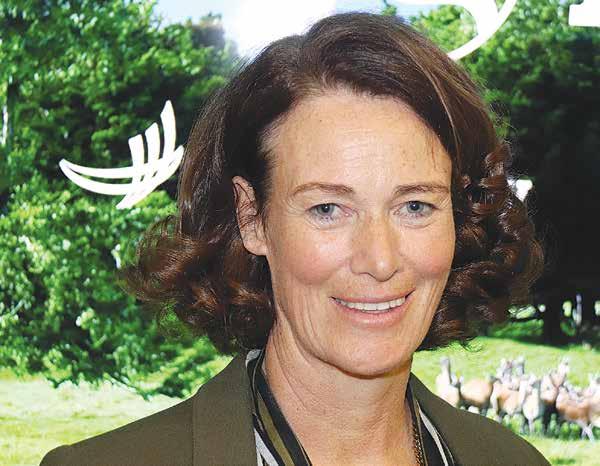
Passion and profit!
Deer Industry NZ chair Mandy Bell wants the deer industry to be recognised as a sector that produces really healthy protein, farmed by people who are passionate about the environment. She made these comments at a recent function at Parliament to celebrate the end of a seven year, $14 million partnership programme between the deer industry and MPI – known as P2P or Passion2Profit. Its aim has been to improve the profitability of the sector and develop new markets for venison. The function was hosted by the Minister of Agriculture Damien O’Connor and included the former chair of DINZ, Bruce Wills, who was one of the drivers of the project. –
See full story page 4
companies significant losses because they have been unable to process valu able co-products – such as tripe and edible offals.
“They are not being saved and col lected simply because there isn’t any labour and those products are going down into the rendering chute and are being downgraded to quite a low value product,” she told Rural News

Karapeeva says meat companies and plants have been very good at
managing the limited number of work ers they have and balancing that out so that they can continue to process. But she says that they are not processing the carcasses completely, so some of that of that finer secondary process ing is being put aside. The result is that extra value is not being realised because the plants are not running at full capacity.
“Shifts are being dropped because there isn’t enough people to run those
shifts and that means that not as much product is being put through as quickly as it should be,” she adds.
Company bosses spoken to by Rural News add that absenteeism is a prob lem caused by Covid, but not exclu sively so. Whereas in the past there has been a pool of labour to fill those gaps when required and this no longer exists.
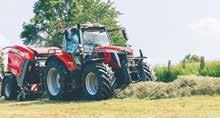
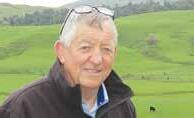
Getting overseas workers into NZ to fill positions in the meat indus

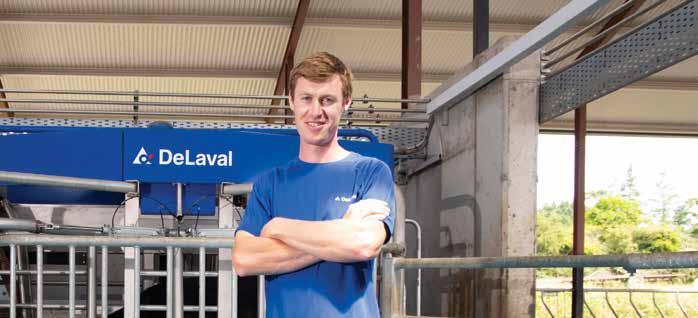
try remains a major concern for MIA and Karapeeva says they want further discussion with the Government to sort out the problems. She adds that the Government has done some good things in the immigration space and the sector has had a few small wins with border exemptions, the new sector agreement and accredited employer visa scheme.
“Collectively, it is starting to ease the problem, but the proof is always in the pudding and what I am concerned about is that it’s great to have that front end right, but everything will come to a standstill if the backend office pro cessing facility for visas is not working well,” Karapeeva adds.
“I am getting quite different reports from companies about their experi ences with Immigration NZ. Some are saying they have got an officer in Immigration NZ who is very focused and on to it and processed visas in a timely way. But conversely I am getting reports that it’s like trying to get blood out of a stone dealing with some immi gration officers and the files just get put at the bottom of the pile, they not hear ing from them and nothing happens.”
She explains that it’s critical for the meat industry that the machinery at Immigration NZ works well and that the visa process is done without due delay. Karapeeva has heard horror sto ries about systems at the department not being up to scratch and compli cated files being allocated to junior staff who are simply incapable of actioning them.
“This is something we will be rais ing with government.”
PETER BURKE
SEPTEMBER 27, 2022: ISSUE 760 www.ruralnews.co.nz TO ALL FARMERS, FOR ALL FARMERS NEWS Maori farm soldiering on. PAGE 15 MACHINERY & PRODUCTS New Massey Ferguson tractors arrive in NZ. PAGE 26 AGRIBUSINESS Lifetime love of land UPGRADE YOUR MILKING SYSTEM? IS I T T I M E TO delaval.com Talk to the Upgrade Specialists 0800 222 228 If you’re thinking about automation, we can help you look at the full picture from rotaries to robots, not just one type of system. B&DEL0577
peterb@ruralnews.co.nz
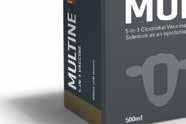






















ACVM No: A934, A935, A11311 & A11766. Schering-Plough Animal Health Ltd. Phone: 0800 800 543. www.msd-animal-health.co.nz ©2022 Merck & Co., Inc., Rahway, NJ, USA and its affiliates. All Rights Reserved. NZ-MUL-2201700001. 1 Baron Audit Data, June 2022 Whether standard, boosted with Vitamin B12 and/or Selenised, the MULTINE ® range can cover your flocks’ essential vitamin, mineral and clostridial protection needs. You can get exactly what your sheep require, right when you need it. That’s why MULTINE ® is New Zealand’s leading 5-in-1 clostridial vaccine range1. Learn more at www.sheepvax.co.nz Available from leading veterinary clinics and rural retailers. With a range of supplementation options to choose from, using MULTINE® ensures you get everything you need – and nothing you don’t. 5-in-1 + 2mg Vitamin B12 + 2mg Selenium 5-in-1 5-in-1 + 2mg Vit. B12 5-in-1 + 5mg Sel. Your farm, your solution. The MULTINE® range lets you manage how you protect and supplement your sheep. VAXIPACK® RECYCLING LEARN MORE
A year like no other!
SUDESH KISSUN sudeshk@ruralnews.co.nz
A STRONG result in a year like no other is how Fonterra chief executive Miles Hurrell is describing the co-oper ative’s annual results.
Fonterra farmers will receive a record milk price of $9.30/kgMS, smashing the previous record of $8.40/ kgMS set in 2013-14.
With a total dividend of 20c/share, fully shared up farmers will get $9.50/ kgMS.
For year ending July 31 2022, Fon terra reported a net profit of $583m from total group revenue of $23.4 bil lion, which was up 11% on the previ ous year.
Hurrell says the last financial year has been a year like no other: the cooperative has shown that these chal lenges make the team stronger.
“In the face of unprecedented mac roeconomic events, we have continued to deliver for our farmer owners and New Zealand, delivering $13.7 billion to the domestic economy in milk price payments alone,” he says.
He thanked farmer shareholders and staff for hard work and resilience during the year.
Hurrell says despite the challenges, including increased costs associated with supply chain volatility, 2021-22 was a good year for the co-op.
“These results demonstrate that our decisions relating to product mix,
market diversification, quality prod ucts and resilient supply chain, mean the co-op is able to deliver both a strong milk price and robust financial performance in a tough global operat ing environment.”
While total revenue was higher, sales volumes decreased due to shortterm shifts in demand and ongoing shipping and supply disruptions.
Strong margins in the ingredients channel, particularly in the final quar ter, resulted in an increase in Fonter ra’s gross profit.
However, total gross margin was down due to the higher cost of milk
$1B CAPITAL RETURN ON TRACK
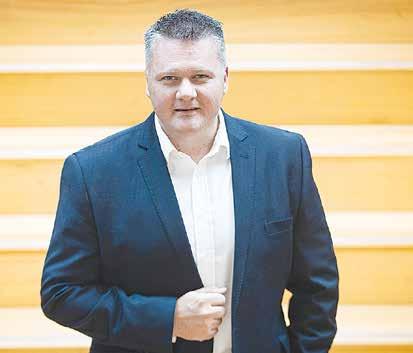
FONTERRA’S PLAN to return $1billion to farmer shareholders and unit holders within two years remains on track.
This is despite the co-op shelving plans to offload part of its Australian business.
Fonterra chief executive Miles Hurrell says the co-operative remains committed to the capital return.
But he adds that things will depend on the co-op’s debt position and the
how much the Soprole business in Chile will fetch.
As part of its strategy to 2030, Fonterra set a goal of a return of about $1 billion to shareholders and unit holders from divestments including Soprole and a stake in the Australian business.
But after looking at options, Fonterra has decided to maintain full ownership of the Australian business.
on foodservice and consumer channels during the year.
A series of geopolitical and eco nomic events also impacted perfor mance with the co-op writing off $80 million its Sri Lankan business, due to devaluation of the rupee.
Performance was mixed across Fon terra’s three regional markets.
Africa, Middle East, Europe, North Asia, Americas (AMENA) saw nor malised earnings before interest and taxes (EBIT) jump 57% to $527m due to the improved gross margin in its ingredients channel.
However, Asia Pacific (APAC) nor

malised EBIT was down 22% to $237 million; improved performance in ingredients channel more than offset by weaker consumer and foodservice channels.
Greater China normalised EBIT was $432 million, up 7%, with an improved performance in its ingredients channel partially offset by lower margins in the foodservice and consumer channels, as a result of the higher cost of milk.
Fonterra’s net debt position rose by $1b to $5.3b, increasing the gearing ratio from 38.5% to 42.4%.
The co-op is putting this down to increased inventory and increased working capital triggered by the higher milk price.
Fonterra chief financial officer Marc Rivers explained that higher inventory than usual at the end of the 2022 finan cial year was due to stronger milk col lections towards the end of the season coinciding with factory constraints, short-term impacts on demand and shipping disruptions.
“Eighty eight percent of our year inventory is contracted, which means the sale price has been agreed and the product contracted, however the inventory had not been shipped at the balance date,” says Rivers.
“The first six weeks of the new financial year have showed good prog ress with shipment of this inventory. We have flexibility in relation to inven tory levels due to the strength of our balance sheet.”
“Australia plays an important role in our consumer strategy with a number of common and complementary brands and products and as a destination for our New Zealand milk solids,” says Hurrell.
“The business is going well, and it will play a key role in helping us get to our 2030 strategic targets.
“Even though we have decided not to sell a stake in our Australian busi
ness, we are still committed to targeting a significant capital return to our share holders and unitholders.
“The amount of any capital return will ultimately be determined on a number of factors, including the successful completion of the divest ment programme as well as our ongoing debt and earnings levels.”
@rural_news facebook.com/ruralnews
Fonterra chief executive Miles Hurrell has thanked farmer shareholders and staff for hard work and resilience during the year.
RURAL NEWS // SEPTEMBER 27, 2022 NEWS 3 HEAD OFFICE Lower Ground Floor, 29 Northcroft Street, Takapuna, Auckland 0622 Phone: 09-307 0399 Fax: 09-307 0122 POSTAL ADDRESS PO Box 331100, Takapuna, Auckland 0740 Published by: Rural News Group Printed by: Inkwise NZ Ltd CONTACTS Editorial: editor@ruralnews.co.nz Advertising material: davef@ruralnews.co.nz Rural News online: www.ruralnews.co.nz Subscriptions: subsrndn@ruralnews.co.nz ISSUE 760 www.ruralnews.co.nz NEWS 1-17 AGRIBUSINESS 18 HOUND, EDNA 20 CONTACTS 20 OPINION 20-23 MANAGEMENT 24 ANIMAL HEALTH 25 MACHINERY AND PRODUCTS 26-30 RURAL TRADER 30-31
Deer industry celebrates successful end to partnership project
PETER BURKE peterb@ruralnews.co.nz

NEW CHAIR of Deer
Industry NZ Mandy Bell wants the deer indus try to be recognised as a sector that produces really healthy protein and is farmed by people who are passionate about the environment.
She says venison is a naturally farmed, healthy, tasty, lean meat high in iron and well suited to consumers who want
healthy food.
Her comments came at a recent function at Parliament to celebrate the end of a seven year, $14 million partnership programme between the deer industry and MPI known as P2P or Passion 2Profit. Its aim has been to improve the profit ability of the sector and develop new markets for venison.

The function was hosted by the Minister of Agriculture Damien
O’Connor and included the retiring chair of DINZ, Bruce Wills, who was one of the drivers of the project. He says while the project did not achieve all the aspira tional goals set out seven years ago, no one could have foreseen the global shut down of the food
service sector due to Covid.

“But venison market ers have done a fabulous job pivoting to retail with prices now well on the way to recovery from the Covid induced slump.”
O’Connor says, from his travels around the country, he sees too many
THE PASSION2PROFIT was part of a primary growth partnership project aimed at improving deer productivity on the farm – as well as developing new markets for venison.
DINZ chief executive Innes Moffat says while there was a lot of good research on the subject of deer reproduction, it wasn’t neces sarily being applied universally on farms. He says the project was aimed at the importance of farmers feeding their animals better so deer could express their genetic potential and also to make sure farmers were using those genetics really well.
“For the farmers who have been really engaged in the

deer fences with no deer behind them. He says there is potential for the industry to grow with out necessarily creating any more infrastructure. O’Connor adds that what started off as fledgling industry has grown, but he would like to see ven ison exports grow more
than the current $150 million.
“I believe the long term target for the indus try should be $1 billion.”

For her part, Bell –who farms deer on Criffel Station, near Wanaka – says the completion of the P2P programme should not be seen as the
end but rather the begin ning of the next phase in the development of a vibrant deer industry in NZ.
“We have come out of P2P motivated and engaged. We’re small, we’re agile and we are integrated,” she told Rural News. “We have the venison and velvet com panies as well as the Deer Farmers Association sit ting at the same table.
“We were the first farming industry to develop environmental awards and an environ mental code of practice. Our farmers are passion ate about their animals and taking the indus try forward and they are eager to be the country’s most respected agri-food industry.”
programme, they have seen some improvement in the productivity of their animals and across the whole herd and we have seen a lift in the reproduction rate of deer,” Moffat explains.
“So, more fawns born and we have seen an increase in the national carcass weight, but we also acknowledge that there is lot more that we can be doing.”
He says the industry’s genetic programme is going ahead in “leaps and bounds”, but the sector is not necessarily seeing the full exploitation of that genetic poten tial.
Moffat says one of the aims for the industry is to ensure venison was available 52 weeks of the

year so that it could be supplying more markets around the world – not just the seasonal and tradi tional European game market, which has a defined window in the months before Christmas. He says the sector has been expanding its markets in North America and China and part of the P2P programme was to give farmers some of the tools to meet these opportunities.
“We had some very excited and engaged customers in 2019 and things were growing. But when Covid struck in 2020 and 2021 basically the restaurant sector in key markets shut down and our markets disappeared,” he told Rural News
However, Moffat believes they are now seeing a strong rebound in the food services sector and customers are returning. He says there is still some hesitancy due to the recession in Europe and, with inflation, dining out is seen as discretionary.
Meanwhile, Moffat says there have been some spill-over benefits from the P2P project – including the fact that farmers involved in the project have developed their own networks. He says they are now using these to help each other with such things as farm environment plans and how to deal with the new regulations.
 @rural_news
DINZ chief executive Innes Moffat, Agriculture Minister Damien O’Connor and DINZ chair Mandy Bell celebrate the end of P2P project at a recent function at Parliament.
@rural_news
DINZ chief executive Innes Moffat, Agriculture Minister Damien O’Connor and DINZ chair Mandy Bell celebrate the end of P2P project at a recent function at Parliament.
RURAL NEWS // SEPTEMBER 27, 2022 4 NEWS
facebook.com/ruralnews
IMPROVING DEER PRODUCTIVITY AND FINDING NEW MARKETS SOUTH ISLAND www.cochranes.co.nz Call Alastair Robertson | 027 435 2642 AMBERLEY | LEESTON | ASHBURTON | TIMARU | OAMARU | WEST COAST NORTH ISLAND www.gaz.co.nz Call our Imports Specialist 027 203 5022 CAMBRIDGE | OTOROHANGA | ROTORUA LOADER WAGONS It’s time to World’s most powerful variable speed clipper is here! handypiece Make dirty jobs EASY this season ■ Ideal for shearing sheep, alpacas, goats and cow tails. ■ Variable speed from 2600-3500rpm. ■ Latest brushless motor technology means minimal heat build up ■ 1400gms means 100-200gms lighter than standard handpiece. ■ At 2800rpm the 12v lithium battery will crutch 300-400 sheep or trim up to 400-500 cow tails. ■ Tough alloy switch box with auto rest fuse for overload or lockup – clips to belt. GET YOUR REPAIRS & SERVICE DONE ASAP! View in action go to www.handypiece.co.nz Freephone 0800 474 327 email: dave@handypiece.co.nz
Move to protect top soil
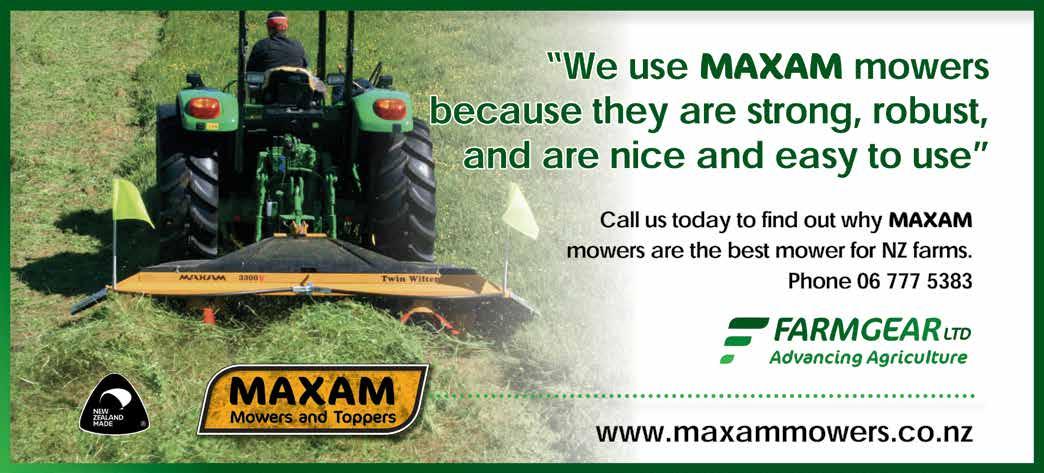 PETER BURKE peterb@ruralnews.co.nz
PETER BURKE peterb@ruralnews.co.nz
THE HORTICULTURE sector is praising the Government’s moves to introduce strict new reg ulations to protect highly productive land used for growing vegetables and fruit.
HortNZ chair Barry O’Neil says the sector is pleased with the plans and it is something it has been advocating for some time. He believes the new regulations will protect highly productive land for this and future genera tions.
During the past 20 years, about 35,000 hect ares of highly produc tive land has been carved up for urban or rural res idential development, while 170,000 hectares has been converted to lifestyle blocks.
The new regulations are enshrined in a docu ment called the National Policy Statement for Highly Productive Land (NPS-HPL). The objec tive is to enhance pro tection for NZ’s most productive land and pro viding security for both our domestic food supply and primary exports.
Environment Minister David Parker claims the NPS will greatly improve how NZ protects highly productive land from inappropriate subdivision, use and development.
“We need to house our people and to feed them too. Our cities and towns need to grow but not at the expense of the land that’s best suited to grow our food,” he says. “This NPS will help protect our best growing areas so Kiwis will continue to have access to leafy greens and other healthy foods.”
Parker says councils will be required to iden tify, map and manage highly productive land to ensure it’s available for
growing vegetables, fruit and other primary pro duction, now and into the future.
Agriculture Minister Damien O’Connor says once land is built on, it can no longer be used to grow food and fibre.

“That’s why we are moving to protect our most fertile and versa tile land, especially in our main food produc tion areas like Auckland, Waikato, Hawke’s Bay, Horowhenua and Canter bury.”
NOT TOO LATE
ADVOCATING FOR governments to act in regard to protecting highly productive soils has been going on for some time, O’Neil says it’s not too late and should result in protecting land in major fruit and vegetable growing areas.
Some local authorities have been strongly criticised for not doing enough to stop productive land going into housing or lifestyle blocks. O’Neil believes the new NPS will clear up any doubts about what they have to do.
“I think local government has been reaching out for direction like this for some time so I believe they will welcome this,” he told Rural News
While the new rules cover all highly productive land, O’Neil says protecting vegetable growing land is the absolute priority.
“If we can’t protect our vege table growing locations we will end up importing frozen vegetables from countries offshore,” he says.
“While more pressing in the vege table space, it also impacts on fruit
production as well.” O’Neil points to the Heretaunga Plains in Hawkes Bay where a significant amount of land has been lost from fruit production. In Bay of Plenty areas such Omokoroa are now just about all housing – with the kiwifruit production area moved to tar seal and concrete.
O’Neil adds it’s not only urban sprawl that has taken highly produc tive land – lifestyle blocks are also an issue. He says often the problem starts with lifestyle blocks which then progresses to high density housing.
Moves to introduce strict new regulations to protect highly productive land used for growing vegetables and fruit has been welcomed.
RURAL NEWS // SEPTEMBER 27, 2022 NEWS 5
US bumps the UK off as top market for chilled NZ sheepmeat
IN A remarkable turn around, the United States has in the past year become the major market for NZ chilled sheepmeat, overtaking the UK which has held this position seemingly forever.

Meat Industry Associ ation (MIA) chief execu tive Sirma Karapeeva says traditionally the US has been recognised as NZ’s major market for manu facturing beef that goes into hamburgers.
“However, what we are now seeing is that the demand for NZ sheep meat is increasing quite strongly. It is becoming perceived in the US as a premium product,” she told Rural News. “The

fact that it overtook the UK as our number one market for chilled sheep meat exports is quite
phenomenal and some thing we need to cele brate.”
Karapeeva says the
success of the past year, which saw red meat exports rise to $11 billion dollars, was due to good
management by the com panies rather than good luck. She says this is due to strong demand and
solid global prices and notes that while volumes of product may reduce slightly, prices are likely to remain firm.
Karapeeva believes the sector’s market diversifi cation strategy is work ing and bodes well for the future.
“We have got access into such a broad range of markets and our com panies have got really good commercial rela tionships across these markets,” she says. “This shows that they are able to anticipate and fill con sumers’ and customer
demands across the globe and shift things around.”
Karapeeva believes the other positive sign is that the food service sector/ restaurant trade is pick ing up in the US, UK and Europe. She says in these places people are learn ing to live with Covid and so more people are eating out. However, she adds that China, which is still pursuing a Covid elimination strategy, is a bit slower but that coun try still remains a major market for NZ.
PETER BURKE
“What we are now seeing is that the demand for NZ sheepmeat is increasing quite strongly.”
@rural_news
The MIA recently held a function, in Wellington, to thank stakeholders and reflect on the past year. It also marked the end of an era where chair for the past seven years, John Loughlin – pictured with Sam McIvor – stepped down and handed over the role to Nathan Guy.
RURAL NEWS // SEPTEMBER 27, 2022 6 NEWS
peterb@ruralnews.co.nz
facebook.com/ruralnews
Something’s wrong with this picture…
Shaw asked to front up
GROUNDSWELL IS call ing on the Minister of Climate Change James Shaw to front up and to discuss the “outstand ing issues” that farm ers have with the current proposed agricultural emissions mitigation rec ommendations.
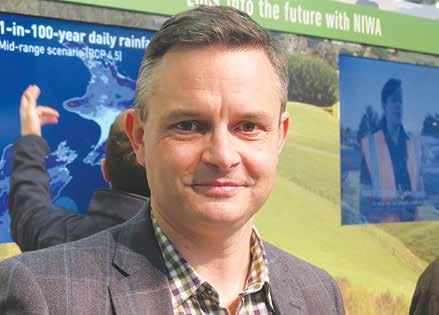
The rural ginger group – and long-time critic of the agricultural sec tor’s He Waka Eke Noa (HWEN) grouping of 11 primary sector bodies who have proposed the current recommenda tions with the Govern ment – says it wants to find a “mutually agreed resolution”.
Groundswell has writ ten to the HWEN Steer ing Committee – as the ag sector’s representa tives – asking it to facili tate a meeting with Shaw.
“Big decisions are being made regarding the design of the emissions pricing mechanism, yet farmers have no under standing of the reasoning behind these decisions,” the letter states. “This is leading to confusion and a lack of trust in the pro cess.”
Groundswell says it is willing to hold a live online meeting with Shaw and it hopes to make this discussion accessible for farmers to follow and engage in.
“We believe this open dialogue will help smooth the pathway to finding mutual agree ment between the farm ing community and the Government and mini mise the risk of further resources being wasted on proposals that do not meet the needs of farm ers.”
The group wants the meeting with Shaw to take place before any further government announcements and deci sions on agricultural emissions pricing.
Groundswell’s farm emissions spokesman Steve Cranston told Rural
News that it is unreason able for Shaw to expect farmers to support an emissions pricing scheme if he is not willing to front up and engage with the farming community on its concerns.
He says one of key issues farmers would
like to be openly debated is what factors are pre venting GWP* from being integrated into the HWEN pricing scheme.
“Farmers want trans parency on the warming effect of our emissions and GWP* appears the best method of achiev
ing that,” he told Rural News. “If the minister has reservations about using GWP*, this is his oppor tunity to explain these to farmers.”
Cranston says farmers also want to know what is restricting the Govern ment from including a wider range of on-farm sequestration for mitigat ing their emissions.
“The Government’s current interpretation of the ‘additionality’ clause excludes vast swathes of regenerating vegetation, which could potentially be included,” he explains.
Cranston adds that farmers are also asking if HWEN’s current inter pretation is in line with our international compet itors or putting NZ farm ers at a disadvantage.
He says there are also questions around HWEN being better used to pro
mote NZ’s farming sector and demonstrate its low carbon and low warming footprint.

“We believe HWEN could be more integrated with other environmental policy objectives,” Crans ton adds. “There are sig nificant opportunities to incentivise biodiversity and water quality objec tives via HWEN, which have not been properly explored.”
Meanwhile, a spokes man for Shaw told Rural News that no decision had been made on him meeting with Ground swell.
“We understand they [Groundswell] have sent a letter to the He Waka Eke Noa Partnership requesting that they facil itate a meeting with min isters, but it hasn’t gone any further than that at this stage.”
DAVID ANDERSON
Climate Change Minister James Shaw is being asked to front up and to discuss the “outstanding issues” that farmers have with the proposed agricultural emissions recommendations.
RURAL NEWS // SEPTEMBER 27, 2022 NEWS 7
We’re here for the good of the country. There’s no doubt it’s a wise move to insure the key assets on your farm. But have you insured your most important assets – yourself and your family? At FMG we’ve been providing affordable access to Life & Health insurance for more than half a century, giving farmers the assurance that their families and their business can be looked after should the worst happen. To find out more, go to fmg.co.nz/somethings-wrong-with-this-picture, or call us on 0800 366 466. the tractor’s insured for more than they are.




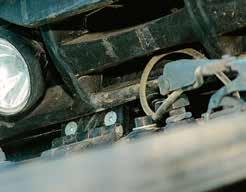
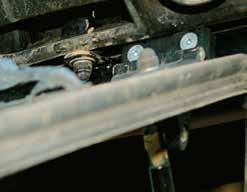


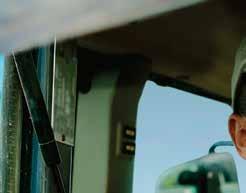
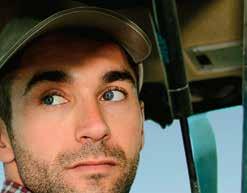



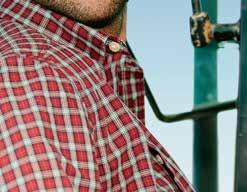


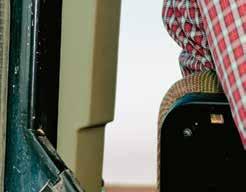
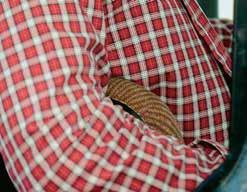

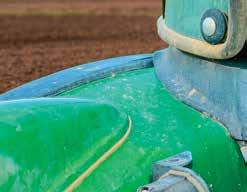
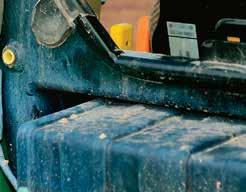









































First Fonterra candidates revealed
BARRON
THE FIRST batch of can didates for Fonterra’s board election has been announced.
Sitting director Andy Macfarlane, former Fon terra manager and com pany director Alison Watters and corpo rate farmer Matt Flem ing are the independently assessed candidates.
The non-assessed can didates, where farmer shareholders can stand as a candidate for the board, had until September 22 to file nominations. The final list of candidates will be announced on Friday, September 30.
Voting Packs, contain ing candidate profiles, will be mailed to farmer shareholders on Octo ber 18, with the results being announced on 8 November. The directors
He will a to be by the 25 at Fonterra’s in early A will also be at the





Barron told Rural that he was was a the to someone else.
“I’m confident now is a good time for succession to happen,” he says.
“There has been a lot going on in the co-op over the last few years. Now we are in a period of relative stability and that allows me to step back and focus on other areas.”
will take up their seats at Fonterra’s annual meet ing on November 10.
This year, Fonterra shareholders will appoint at least one new director, with Edgecumbe farmer
Donna Smit retiring after serving six years on the board.
Macfarlane, a farm management consult ant, was elected to the board in 2017 and is seek
ing another three-year term. Macfarlane’s farm ing interests encompass multiple equity partner ships: the family lives near Ashburton on ‘Pen carrow Farm’, which has a high profile for its envi ronmental record.
Macfarlane is a direc tor of ANZCO Foods


Limited and a past pres ident of the New Zea land Institute of Primary Industry Management. He has also served as chair of Deer Industry New Zealand for seven years and a director of AgResearch for six years.
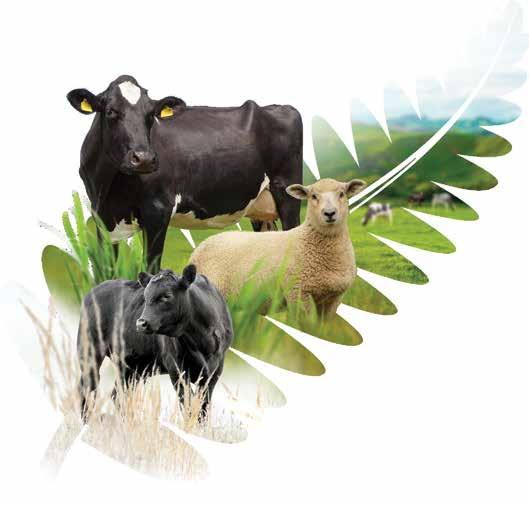
Alison Watters and her husband Andrew and
other family own a 510cow dairy unit in the Wairarapa.
They are the fifth gen eration to farm the family property and it is a pri ority for them that their farm and the industry provide an opportunity for their two daughters to see a future in dairy.
The Watters won the NZ Sharemilker of the Year title in 2003.
Watters was a tech nical manager (nutri tion and bioactives) at Fonterra from 2006-2011, managing a team of sci entists and technolo gists developing specialty ingredients for human health and well-being.
Currently, she chairs AsureQuality and is a director of LIC and Met Service.
Fleming has held exec utive management and governance roles in agri business for the past 20 years.
He’s currently chair of Fortuna Group Limited, which has grown to 19 dairy farms in Southland, and is a director of Better Eggs Limited, which is NZ’s second largest egg producer. He continues to be an advisor to farm ing families and trusts.
SUDESH KISSUN
FONTERRA CO-OPERATIVE Council chair James Barron stepping after in the role.
Barron, who represents South Waikato on the council, retires
Current Fonterra director Andy Mcfarlane is competing for two available board seats against challengers Matt Fleming and Alison Watters.
RURAL NEWS // SEPTEMBER 27, 2022 NEWS 9
sudeshk@ruralnews.co.nz
is
down
three years
by rotation this year and isn’t seeking re-election.
hand over to
new chairman,
elected
councillors,
annual meeting
November.
new councillor for South Waikato
elected
annual meeting.
News
confident now
good time to step down and hand over
reins
TO STEP DOWN
COMMITTED TO NEW ZEALAND. COMMITTED TO YOU. We’re here for NZ farmers for the long haul. We’re Boehringer Ingelheim, the name behind the brands trusted by farmers. Season after season, brands like ECLIPSE®, E PRINEX®, MATRIX® and BIONIC ® have been trusted on farm to deliver exceptional health and production outcomes for farmers. Boehringer Ingelheim is the name behind these brands that continues to invest in NZ agriculture by developing and manufacturing these products right here in NZ, ensuring kiwi farmers maximise production - not just this season, but for many, many more to come. BOE1319 futureproducers.co.nz PROUDLY AVAILABLE FROM YOUR LOCAL PARTICIPATING VETERINARY CLINIC. Boehringer Ingelheim Animal Health New Zealand Limited. Level 3, 2 Osterley Way, Manukau, Auckland, New Zealand. MARKS-MIN , EPRINEX ECLIPSE , MATRIX , and BIONIC are registered trade marks of Boehringer Ingelheim Vetmedica GmbH, used under license. Registered pursuant to the ACVM Act 1997, No. A011687, A007191, A009270, A011151, A009390, A011825. See product label for full claim details and directions for use. © Copyright 2022 Boehringer Ingelheim Animal Health New Zealand Limited. All rights reserved. NZ-BOV-0009-2022.
A lack of Ag knowledge
A NEW study in Austra lia has identified a lack of agricultural knowledge among school students, highlighting a need for better agricultural educa tion programs.
In the largest ever study of its kind CQUni versity’s Agri-tech Edu cation and Extension research team, led by Dr Amy Cosby, surveyed more than 5,000 primary and secondary students across Australia about their knowledge of agri culture.
The study found many students thought of agriculture as a lowtech industry; four in five primary students and three in five secondary students believe commercial milking of cows occurs by hand rather than machine.
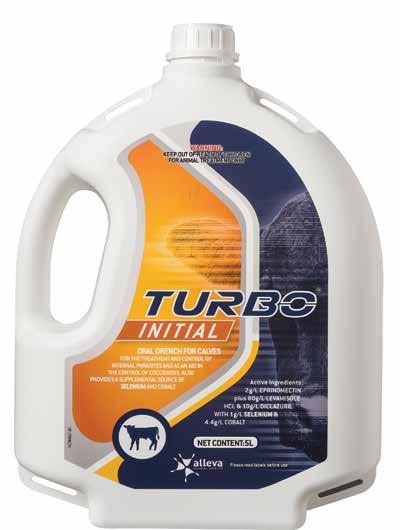
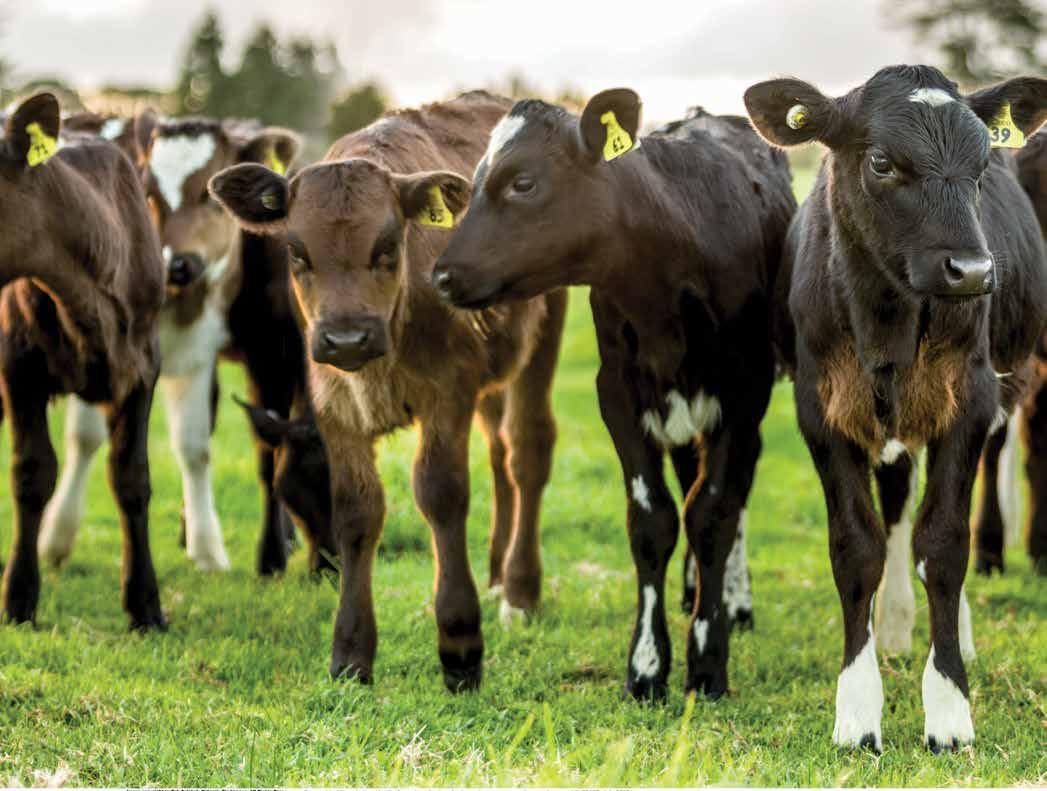
Awareness of agricultural careers was also limited with many only able to recognise traditional job roles such as ‘farmer’ and ‘beekeeper’.
Importantly, the study showed one of the key factors impacting stu dents’ agricultural knowl edge was their level of exposure to farms, with students who live on a farm or who visited a farm at least four times a year scoring significantly higher than those who had never been to a farm.

Cosby said this high lights the importance of including regular expo sure to farming activities in agricultural programs for Australian schools.
“If students are not being shown an accurate vision of modern agricul ture they are unlikely to recognise that agricul tural jobs can be highly
skilled, well paid and pos sibly located outside rural areas.”


She adds that although agriculture is in a period of rapid technological advancement modern farming practices are not
being adequately por trayed to students, calling this a likely contributing factor to the industry’s current skilled workforce shortage.
Except for New South Wales’ Years 7-8 curricu

lum, agriculture as a sub ject is not a mandatory inclusion in most Austra lian schools.
Most surveyed stu dents could recognise that some fruits and veg etables grow better in

certain parts of the world and just over half of sec ondary students under stood that hormones are not given to chickens to make them grow (a prac tice banned in Australia since the 1960’s).
Cosby says the study highlights the need for a formal framework to assess students’ agri cultural literacy simi lar to the United States National Agricultural Literacy Outcomes (NALOs), calling the absence of an Australian agriculture literacy frame work a “significant defi cit” limiting agricultural education.
“Today’s students are tomorrow’s consum ers and their future pur chasing decisions will be shaped by their under standing of things like animal welfare, environ mental sustainability and healthy eating practices,” she explains. “Nothing beats exposing students to agricultural work places in real life and to people who work in these careers.”
LEO ARGENT
The study identified a lack of agricultural knowledge among school students and suggests exposing students to agricultural workplaces and to people who work in the sector as a way of rectifying this.
RURAL NEWS // SEPTEMBER 27, 2022 10 NEWS
TURBO® CATTLE DRENCH PROGRAMME STAGE 1 TURBO® Initial Oral Drench STAGE 2 TURBO® Advance Oral Drench alleva.co.nz TURBO® is a registered trademark of Alleva Animal Health Ltd. TURBO Pour-on (A011722), TURBO Injection (A011742), TURBO Initial (A011703) and TURBO Advance (A011714) are registered pursuant to the ACVM Act 1997. See www.foodsafety.govt.nz for registration conditions. INITIAL Stage one of the TURBO 3-stage Cattle Drench Programme. Exclusive to veterinary practices nationwide. THE PROVEN WAY TO WEAN. COMBAT Parasites + Coccidiosis in a single dose STAGE 3 TURBO® Pour On or Injection
Three-way battle for LIC board seat
A THREE-WAY battle is underway for one South Island seat on LIC’s board.
Three well-known dairy farmers – Siob han O’Malley, Corrigan Sowman and Victoria Trayner— are fighting for the new seat.
Changes introduced in 2020 reduced the number of elected LIC directors from seven to six and the number of regions from four to two. After this year’s election, there will three directors each from the North Island and South Island.

Voting papers were sent to LIC shareholders last week: results will be announced at LIC annual meeting in Palmerston North on October 20.
O’Malley, the founding chair of Meat the Need charity, sees LIC as aligned with her “passion for being a sector ambassador” and long-term governance aspirations.
Her family farming interest, Pukeko Pastures, began in 2011 as a share milking business. It now owns a dairy farm milking 180 cows. She is a gradu ate of the Kellogg Rural Leadership Programme and previous sharemilk ers’ representative with Federated Farmers.
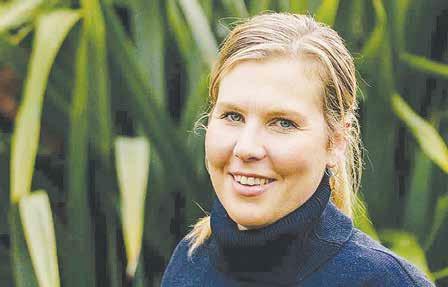
As chair of Meat the Need, she engaged Silver Fern Farms, Miraka and
Fonterra to partner with and sponsor the pro gramme. O’Malley has helped lead the trust’s rapid growth to an expected product value of $10m next year.

Sowman draws from a number of South Island dairy farming leadership and representative roles. He says he’s motivated to join the LIC board as a way to continue con tributing to the sec tor’s success while also strengthening his gover nance experience.
Sowman is the owner, director and business manager of Uruwhenua Farms, a 400ha dairy farm. His earlier career involved roles in farm research and consul tancy. He is both a Nuff ield Farming Scholar and Kellogg Rural Leadership Scholar.
He is the current farmer member on the Fonterra Sustainability Advisory Panel, a group providing independent advice to the Fonterra board.
Trayner draws from a broad agribusiness and education background and is motivated for the LIC role as an oppor tunity to “give back” through shareholder rep resentation. She notes her close alignment to the co-operative values and focus on intergenera tional value.
Trayner has exten sive primary sector expe rience through her own




and family farming enter prises, including dairy farms, pig farms, Angus beef stud and dairy bull run-off. She is currently a tutor in agribusiness and production management through AgriLearn and a
director of Waimakariri Irrigation Limited.
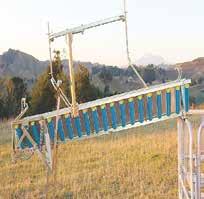
Victoria Trayner is competing against Siobhan O’Malley and Corrigan Sowman for the one South Island seat on LIC’s board.

RURAL NEWS // SEPTEMBER 27, 2022 NEWS 11
VETMARKER FREEPHONE 0800 DOCKER 0800 362 537 www.vetmarker.co.nz • Vaccination • Earmarking & tagging • Castration • Drenching • Automatic flystrike application • Releases lambs onto their feet DOCKING LAMBS IS EASY WITH THE VETMARKER See website gallery: www.vetmarker.co.nz or Vetmarker on Facebook to view NEW MODEL ® CFMOTO NORTH ISLAND CFMOTO SOUTH ISLAND Andys Moto Services, Waiuku (027) 944 5442 Brown Brothers Bikes, Whanganui (027) 572 7696 Country Engineering, Tauranga (07) 552 0071 Country Machinery, Sanson (06) 825 6400 Dr Moto, Tauranga (07) 578 9902 DP Williams, Gisborne (06) 863 2612 Gatmans Mowers, Silverdale (09) 426 5612 Hamilton Motorcycle Centre, Hamilton (07) 849 1919 JC Motorcycles, Waitara (06) 754 6420 Maungaturoto Motorcycles, Maungaturoto (09) 431 8555 Action Sports Direct, Wanaka (07) 928 8045 Ag & Auto Direct, Balclutha (03) 418 0555 Colin Clyne Motorcycles, Oamaru (03) 437 0559 Dan’s Motor Centre, Geraldine (03) 693 8536 Diesel Tech Machinery, Methven (03) 302 8946 Franks Motorcycles. Mataura (03) 203 7309 Ian Day Lifestyles, Alexandra (03) 448 9007 Marlborough Motorcycles, Blenheim (03) 579 2500 Nelson Motorcycles, Nelson (03) 548 3786 Remarkable Motorcycles, Queenstown (03) 441 4653 Vallance Machinery, Fernside (03) 313 6465 *Ride away prices quoted exclude GST. See www.cfmoto.co.nz for more information. Motorcycle HQ, Pahiatua (06) 376 7163 Northland Powersports, Whangarei (09) 437 5451 Outdoor Power, Hastings (06) 878 2369 Peninsula Motorcycles, Thames (07) 868 6104 Powerhead Motorcycles, Manurewa (09) 297 7145 RevTech Powersports, Stratford (06) 765 7712 Rob Titter Farm Services, Kaikohe (09) 401 1774 Rouse Motorcycles, Hikurangi (09) 4338 471 Tahuna Motorcycles & Atvs, Tahuna (07) 887 5790 www.cfmoto.co.nz With refinements across the board, introducing the newgeneration CFORCE 400, 400 EPS and 520 EPS. LIGHTER, STRONGER, SMARTER! Stronger than ever with a 612kg towing capacity 25% tighter turning radius 50% more front and rear rack capacity 30% stronger 10% lighter 26% more suspension travel 21% more fuel capacity 25% less heat emission Reduced vibration Key refinements $7,490 EX GST RIDE AWAY $8,490 $9,490 30 hp, 400cc EFI engine CVTech transmission Engine braking 2WD/4WD with locking front diff Hydraulic disc brakes Dual A-arm suspension Steel wheels 24 inch 6ply tyres 612kg tow capacity 30kg / 60kg rack capacity 30 hp, 400cc EFI engine Power steer CVTech transmission Engine braking 2WD/4WD with locking front diff Hydraulic disc brakes Dual A-arm suspension 2500lb winch Alloy wheels 24 inch 6ply tyres 612kg tow capacity 30kg / 60kg rack capacity 34 hp, 495cc EFI engine Power steer CVTech transmission Engine braking 2WD/4WD with locking front diff Hydraulic disc brakes Dual A-arm suspension Alloy wheels 25 inch 6ply tyres 5-inch LCD display LED headlights 2500lb winch Handguards 612kg tow capacity 30kg / 60kg rack capacity EX GST RIDE AWAY EX GST RIDE AWAY SUDESH KISSUN sudeshk@ruralnews.co.nz
Hard Work(er) paying off
With the Agricultural Marketing and Research Development Trust (AGMARDT) inviting emerging agribusiness sector leaders to apply for its recently opened 2023 Leadership Scholarships, Leo Argent talks to leadership scholar recipient Alex Worker.


ALEX WORKER says he got interested in the leadership path from his family connections.
“My grandfather was a grass scientist who studied under Campbell McMeekan then went to the World Bank helping to develop rural econo mies around the world,” he told Rural News. “My father is a diplomat and my grandmother and mother have been public servants and teachers. I came from a very public lens of service and the idea of what’s good for NZ.”
As a venture partner in several business and steering committees, as well as the founding chair
of Future Food Aotearoa, Worker will have plenty of opportunities to put his studies into action.

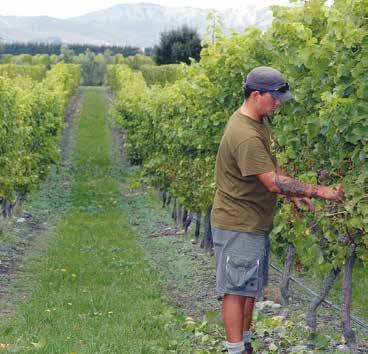
“The scholarship is a total enabler so I’m really grateful because it actu ally provides an opportu nity I wouldn’t otherwise have,” he explains.
“What I’m keen to understand is, what does great governance look like… how do you govern and support through sys tems change in light of disruption and also making the most of new opportunities?”
Worker says that he appreciates AGMARDT taking a risk on his pro file, being neither a farmer nor directly
involved in the industry.
“I’m more on the entrepreneur or venture builder side. I’m not a farmer, but I have worked in companies that repre sent farmers. I’m of this vision that most oppor tunity is going to come from change and a lot of that is recognising where we come from but also where we’re going.”
Worker believes that while government can open doors for indus try, it is up to industry to walk through those doors and keep them open. He also says that identity divisions between urban and rural communities will not help move us for ward.
“The inverse is if we talk about what’s good for New Zealand with a positive vision for our food and fibres,” he adds. “It doesn’t matter if you’re in the city or on farm, industry or gov ernment, we can all get behind that.”
He says with a nontraditional agriculture background and entrepre neur voice, having sup port from AGMARDT empowers him because it shows the organisation is supporting new direc tions and voices.
AGMARDT chair Nick Pyke says that they are looking for innovative, influential, forward think ers like Worker wanting to change the world for the better.
“They will have a clear and distinctive plan for their growth and devel opment toward taking up influential roles in the sector; a diverse pro
gramme of activity that will build their capability across a range of areas.”
With a maximum of $15,000 per scholar, scholarships are available annually to New Zealand citizens or permanent residents and success ful scholarship applicants will be able to participate in programmes related to food and fibre sectors, develop management skills in New Zealand and abroad and more.
AGMARDT leadership scholar recipient Alex Worker.
RURAL NEWS // SEPTEMBER 27, 2022 12 NEWS
TO ALL FARMERS. FOR ALL FARMERS. HORTNEWS RURAL NEWS TO ALL FARMERS, FOR ALL FARMERS www.ruralnewsgroup.co.nz
Looking after kiwi farms for generations. to introduce a in collaboration to on New Zealand looking grandchildren


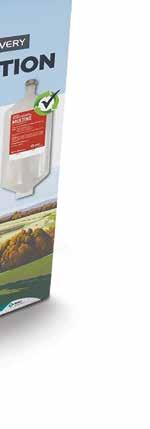

You of the rest, in the following products:



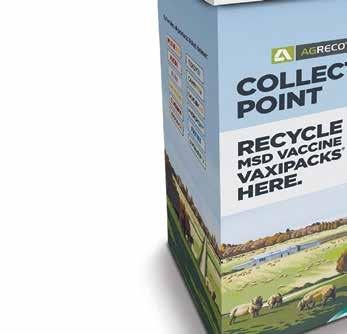
ACVM No’s A934, A11311, A3977, A1009, A1992, A9028. AVAILABLE ONLY UNDER VETERINARY AUTHORISATION. ACVM No’s: A4769, A9535, A7886, A9927, A1948, A6151 Schering-Plough Animal Health Ltd. Ph: 0800 800 543. www.msd-animal-health.co.nz © 2022 Merck & Co., Inc., Rahway, NJ, USA and its affiliates. All rights reserved. NZ-YER-220700001
We’re excited
new sustainability initiative
with Agrecovery aiming
help reduce plastic waste
farms. Let’s continue
after our farms so our children and
can do the same.
can drop empty MSD Vaccine Vaxipacks® in collection bins at participating vet clinics and rural retailers. We’ll take care
ensuring the plastic is repurposed and doesn’t end up
landfill. To find out more talk to your local vet clinic or rural retailer or visit: www.sheepvax.co.nz/recycling Recycle MSD Vaxipacks® from
VAXIPACK® RECYCLING LEARN MORE
Work-based training that fits your business
Our training will be relevant to the needs of business and industry.
Te Pūkenga is working towards a modern, future-fit workforce for Aotearoa.
Find out more at tepūkenga.ac.nz

Maori farm soldiering on
There was a huge turnout for a field day of the last of the three finalists in the Ahuwhenua Trophy competition to determine the top Māori sheep and beef farm. Around 300 people attended the event at Hereheretau Station, a mainly hill country farm, located 30km north of Wairoa.
Peter Burke reports…
BEING ON quite hard hill country, those attend ing the field day had to bring their own quad bike or side-by-side, or cadge a ride, to see the farm and the huge devel opments that have taken place on it.
The weather held out and the farm tracks were in good order for the tour, which unveiled some spectacular scenery.
Hereheretau Station is a 2,000 hectare sheep and beef farming oper ation and is the major asset of the Māori Sol diers Trust. This was set up in 1917 to help local Māori veterans returning
from the First World War. The farm is vested in the Māori Trustee, who is the CEO of Te Tumu Paeroa – meaning it is Māori freehold land as opposed to being owned by a par ticular trust or incorpo ration.
The farm runs 25,000 stock units with a 55/45 ratio of sheep to beef. In addition to the land it owns, the station also leases some surrounding blocks to add to its scale and deal with the vagaries of the East Coast climate. It also has a policy of renewing about 35 hect ares of pasture each year.
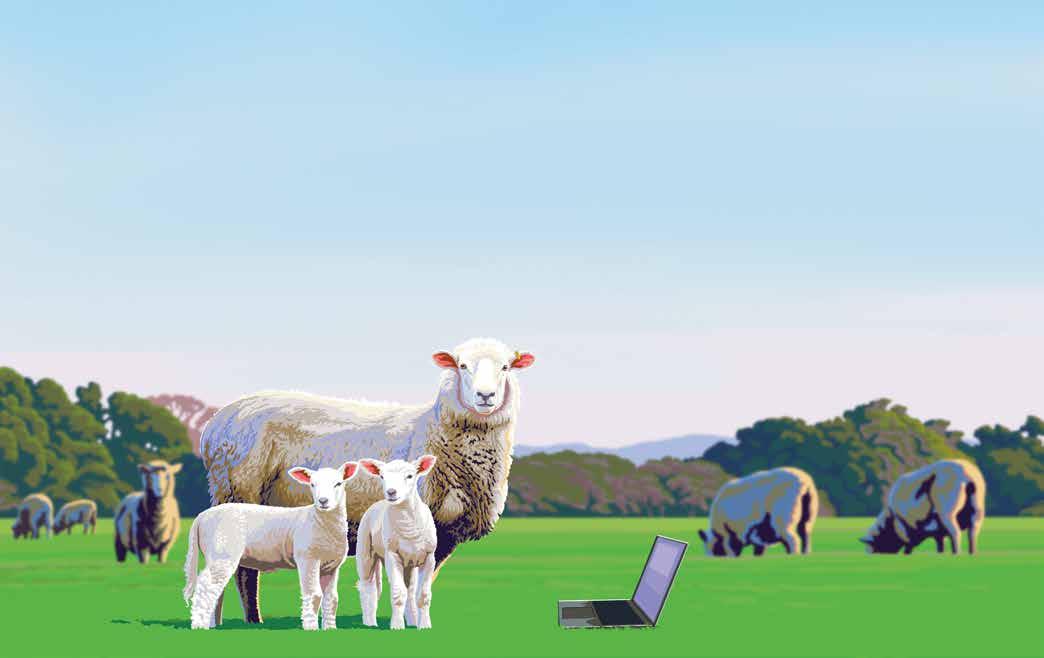
Pete McKenzie has
been a supervisor on the farm for the past 23 years, implementing and over seeing many changes during that time. He describes Hereheretau as both a breeding and fat tening unit running a total of just over 17,000 sheep and 2,000 cattle.
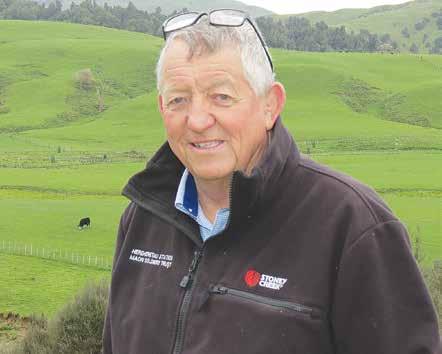
In terms of sheep, there is a terminal flock where a black faced sire is put over the Romney ewes and the aim is to get 4,000 lambs and ewes off to the Affco works at Wairoa in December to de-stock the property for the summer dry.
The station also has a large breeding flock
and lambs from this unit are also fattened on the property. They also mate up to 1,000 hoggets each year.
“We try to sell our stock on the high shoul ders and one of these high shoulders is preChristmas so we try and get rid of 1,600 lambs then,” McKenzie told Rural News
Facial eczema has been a problem on Here heretau but this has been solved by obtain ing Romney rams that are FE tolerant. Flystrike and worms are also an issue. The wet weather has added to the problems
and this has resulted in a slight shortage of grass. McKenzie says he’s been putting on a bit of nitro gen to get the grass grow ing again.
In terms of cattle, Hereheretau runs 700 cows which are a cross
between the shorthorn and the Angus.
“The shorthorn has good milking ability and is a very placid animal,” McKenzie explains.
They use Simmen tal as the terminal sire. About a quarter of the



steers are taken through to 18 months and sold before Christmas and the same applies to cull heif ers.
McKenzie says, on the margins, they buy in 400 steers and 4,000 lambs and these are traded.
Hereheretau Station farm supervisor Pete McKenzie has seen many changes on the farm during his 23 years on the property.
RURAL NEWS // SEPTEMBER 27, 2022 NEWS 15
New disease prevention resources for sheep born in the digital age. Visit sheepvax.co.nz ACVM No’s A934, A11311, A11766, A9028. Schering-Plough Animal Health Ltd. Ph: 0800 800 543. www.msd-animal-health.co.nz © 2022 Merck & Co., Inc., Rahway, NJ, USA and its affiliates. All rights reserved. NZ-MUL-220800001 Up-to-date animal health information for New Zealand farms Vaccination options and product comparisons: Detailed ROI calculators
Defending their legacy
PETER BURKE peterb@ruralnews.co.nz
MOST OF the Ahu
whenua farms have inter esting histories and Hereheretau is no excep tion.

Sir Āpirana Ngata was one of those instrumental in setting up Herehere tau for the express pur pose of benefiting Māori veterans from WWI. That legacy continues today but has been expanded to include veterans from WWII and other conflicts and dependents of Māori veterans.
The actual role of the trust was formalised in 1957 and one feature of this was the estab lishment of a Māori Soldiers Trust scholar ship account. In 2021, 70 people received Sir Āpirana Ngata schol arships ranging from
$1,000 to the $3,000.
The Soldiers Trust Committee consists of the Minister of Māori Development and the Māori Trustee – but all other members must be, where practical, either Māori veterans or Māori who are currently serving in the armed forces.
One such person is lawyer Brigadier Lisa Ferris who heads the legal services Division of the NZ Defence force based in Wellington. Born and raised in Gisborne and of Ngati Porou descent, she joined the army in 2003 and has held a range of positions within Defence Legal Services group.
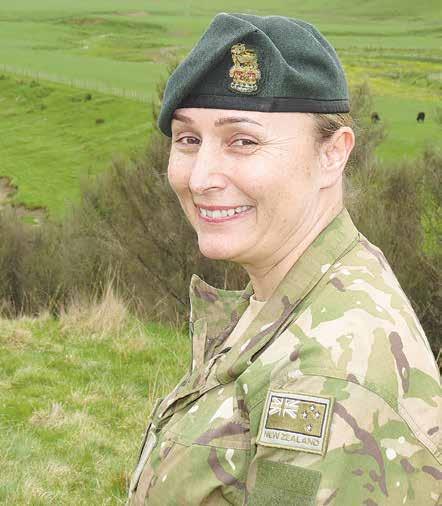
Her role today, as a member of the Māori Soldiers Committee, is to help oversee the dis bursement of scholar ships – a task she enjoys. While Ferris is not
directly connected with the land at Hereheretau, she has military connec tions going back to WWI.
“My great grandfather served in the Māori Pioneer Battalion and served at Gallipoli along with my grand uncle, who died at Chunuk Bair,” she told Rural News. “My great grandfather was also the recruiting officer for the 28th Māori Battalion, Charlie company and was responsible for a lot of the recruitment in the area for WWII.”
Ferris is following in the footsteps of her ancestors and is quick to point out that as a lawyer in the Defence Force she is far from desk bound. She says in the modern military the lawyer is an integral part of the deployment team because there is a lot of legal
compliance and ethical standards to deal with.
“I’ve had a number of deployments includ ing being on the frig ate HMNZS Te Mana, which was a five month deployment to the Gulf of Oman. I was also deployed to Afghanistan and Iraq,” she adds.
At the Hereheretau field day Ferris played a key role in the formal proceedings of greeting visitors to the local marae and farm. Along with staff member Paul Te Aho, Ferris was chosen to receive the medal for the farm being a finalist in the Ahuwhenua competi tion from Associate Agri culture Minister Meka Whaitiri.
Ferris is proud of her heritage and her job. She says since signing on with the army 20 years ago, she’s never looked back.
Brigadier Lisa Ferris, who heads the legal services Division of the NZ Defence force in Wellington, sits on the trust that oversees Hereheretau Station.
RURAL NEWS // SEPTEMBER 27, 2022 16 NEWS
Visit us at corteva.co.nz ®, ™ Trademarks of Corteva Agriscience and their affiliated companies. COR_FWPSTBR_CTA0019 Watching over your brassica crop so you don’t have to. Our portfolio of powerful, proven products has helped farmers from one end of the country to the other create and maintain thriving businesses, and has earned us a reputation as New Zealand’s brassica protection specialists. With every product suitable for ground or aerial application, our suite of herbicides and insecticides provides local farmers with everything they need to win the war on pests and weeds. Visit corteva.co.nz to view our range of online brassica resources. HERBICIDE Arylex™ active HERBICIDE POWERFLO™ Versatill™ INSECTICIDE Jemvelva ™ active Sparta™ INSECTICIDE Qalcova active Naturalyte™ Entrust™ SC INSECTICIDE Isoclast™ active Delivering a complete suite of crop protection solutions for today’s forage brassica growers.
A pilot with passion who is flying high
An innate passion for ag aviation has led to an Aussie born, but essentially kiwi guy, being named as NZ’s Emerging Ag Pilot at the recent NZ Ag Aviation Association conference. The award recognises the individual’s commitment to all aspects of his role as pilot – especially safety and commitment to constantly improving systems.


Peter Burke reports…

THIRTY TWO year-old Scotty Dunkerley flies out of Aerospread’s base in Napier.
The people who nomi nated him for the award said they “couldn’t think of anyone more deserv ing of a NZAAA award. Scotty has the poten tial to have a long, dis tinguished career as a AG pilot in New Zealand. He has the support and encouragement from his friends, family and work mates. He has the deter mination, passion and attitude to excel in our industry”.
Dunkerley is a third generation pilot; his father was a flight instructor at an aero club in Australia, before the family moved to NZ when Scotty was 13. His grandfather was a pilot for SAFE Air where he flew Argosy and Bris tol Freighters – the latter sometimes referred to as 50,000 rivets flying in formation. These aircraft at one stage serviced the
Chatham Islands.
Dunkerley’s dream of becoming an ag pilot began when he was at high school in Feilding, where he could see and hear topdressing aircraft taking off and landing at the local airfield. This, combined with his love of agriculture, saw him at the age of 16 quit school and take up a job in for estry. The purpose was funding his private pilot’s licence – the first step to a commercial licence and a career in agricultural aviation
He then brought a share in a Cessna 180 and flew this all over the country getting his hours up and pursuing his other passion – hunting. While in Motueka, Dunker ley gained his commer cial license in 2014 while working on farms as a shepherd, fencing, shear ing and doing anything possible to self-fund his study as a pilot. He also worked for a tourist oper ation in Northland and
had a job flying hunt ers in and out of hunt ing blocks all over the country.
However, his break into the ag aviation industry came when he was offered a job as a loader driver with Grif fin Ag.

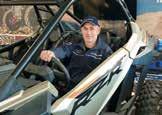
“I did that for two years and it would seem that Hallet Griffin had a quiet word with the owner of Aerospread, Bruce Petersen, and said maybe he should offer me a seat as pilot,” Dunker ley told Rural News. “I worked for him for about a year as a loader driver, which is a prerequisite before becoming a pilot.”
From there began the long and precise training programme – managed by Bruce Petersen, who is a qualified ag instruc tor. For the next 150 hours, Dunkerley had to have Petersen squeezed alongside him in the cockpit of the Cresco as he completed his dual instruction. Petersen is
LIVING THE DREAM
DUNKERLEY SAYS he’s pretty gobsmacked at receiving the award.
He acknowledges the support of his friends and colleagues and espe cially his wife Lindsay – whom he says he couldn’t have got where he is without her.
Dunkerley says he told Lindsay, long before they were married, that he wanted to be a topdressing pilot and that meant early morning starts, going anywhere the job took him and possibly missing birthday parties.
Today he is living his dream.
no small man and much play has been made of how it would have been pretty cosy for both in that 1,000 hour training
“Not every day is the same and it’s just being in the rural scene,” he told Rural News
“Flying is demanding and requires concentration – especially take-offs and landings on some of the short airstrips. With take-offs it’s about getting the weight right and getting airborne and landing is also chal lenging with the wind behind you on an uphill strip.”
But for Dunkerley, the winning of the emerging ag pilot of the year is the start of more things to come. He
period. “After the 1,000 hours of dual, you have a flight test and once you pass this you get your grade 2 certificate,”


loves flying the 750hp Cresco, which he describes as a beautiful, nimble aircraft.
He talks about the hundreds of airstrips he flies from, the challenges of this and how the night before he looks at the map of the farm he’s going to and works out the most effi cient way to spread the fertiliser.
Finally, as his career develops, he hopes that in time to gain the expe rience and possibly become an ag instructor.
Dunkerley explains. “But you have to do another 1,000 hours of ‘supervi sion’ with the instructor at the airstrip monitor
ing your performance. Only then, and after pass ing a further test, are you qualified to fly alone and unsupervised.”
Scotty Dunkerley’s passion for ag aviation saw named as NZ’s Emerging Ag Pilot at the recent NZ Ag Aviation Association conference.
RURAL NEWS // SEPTEMBER 27, 2022 NEWS 17
YOUR LOCAL POLARIS EXPERT WILL STEER YOU RIGHT Across New Zealand the Polaris Dealer Network is made up of over 30 Independent local businesses. Most are privately owned and many have been in operation for generations. Your Polaris dealer is your Local expert on all things Off Road vehicles helping you with the right advice to choose the correct vehicle for your needs and ensuring you have the best possible service and support. Their commitment and Investment to provide their customers with the very highest quality Customer Service is a big reason why POLARIS IS THE #1 SELLING SxS BRAND IN NEW ZEALAND SEE YOUR LOCAL POLARIS DEALER TODAY! Dan Benjamin Jacks Machinery Alton Rodgers Action Equipment Hamilton Geoff Gray Temuka Motorcycles
Lifetime love of land and livestock
JENNI VERNON reckons her love for the land and livestock was forged as a child, helping her grand father feed out mangels on farm.
Today, after more than four decades in farming and public sector lead ership, she remains pas sionate about giving back to the industry.
Vernon has taken on the role of independent chair of the steering com mittee for the Hill Coun try Futures Partnership programme. It’s a task she combines with her job as a principal adviser for the Ministry for Pri mary Industries and other governance posi tions – including with the Agri-Women’s Devel opment Trust (AWDT) and the National Fieldays Society.
Vernon was also New Zealand’s first female Nuffield Scholar and the first woman chair of Environment Waikato.
With research work undertaken for the five year, $8.1m Hill Country Futures Partnership pro gramme now drawing to a close, she is looking for ward to seeing the longterm outcomes for hill country farmers.
“This is only the beginning of the jour ney and that’s why I find it so exciting. We have study sites all over New Zealand and people have been very keen to engage with the programme,” she explains.
Vernon says the next step is to put all this sci ence and research into
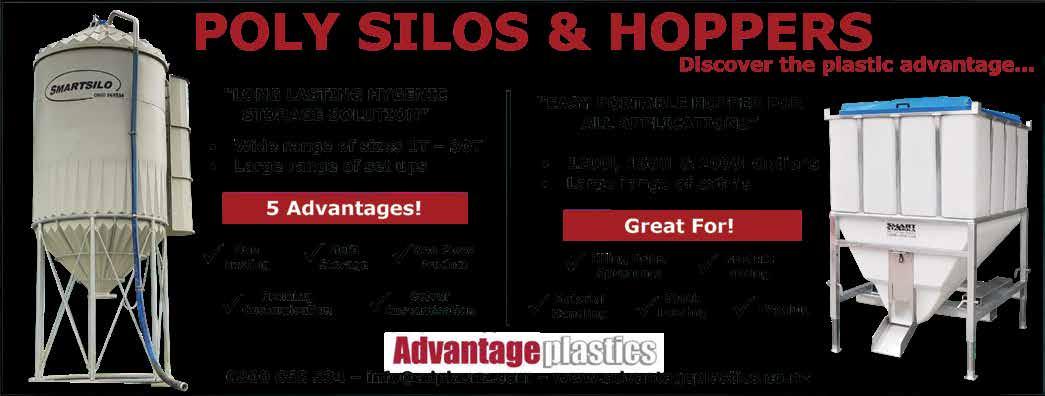
tangible tools.
“A big part of it has been about recognising how valuable hill coun try farming is to New Zealand society and ulti mately the work that has been done will also add value to our markets.”
The five year pro gramme is co-funded by Beef + Lamb New Zea land, the Ministry of Business, Innovation and Employment, PGG Wrightson Seeds and Seed Force New Zealand. It is focused on future proofing the profitability, sustainability and wellbe ing of New Zealand’s hill country farms.
The programme incorpo rates traditional science research, farmer knowl
edge, social research and citizen science. It has a strong emphasis on for ages and providing deci sion-making tools to help farmers select the best forage option for different land manage ment units. Vernon sees the project as important because she believes that hill country farming in the New Zealand is often neglected.
“When I was growing up, following my grand father around in the Rua hine Hills, sheep and beef farming was front-ofmind when New Zealand agriculture was men tioned. Today, you hear more about dairy and kiwi fruit. But there is still a huge acreage of hill
country farming that is very valuable to our econ omy and has some of the most unique rural com munities,” she explains.
“New Zealand needs hill country farming and we need future hill coun try farmers. The Hill Country Futures Partner ship is about how we still have those rural commu nities and how we help the sector to remain prof itable and resilient in the face of many challenges.”
Vernon says she’s excited about the oppor tunities around biodi versity and the forage landscape, including the potential to integrate natives shrubs as graz ing fodder as part of integrated farming sys
tems. “We now have a national database, which will expand, and can be accessed to find if a plant will grow in a particu lar location. I think that will be of great value alongside the land classi fication tools and under standing what legumes and crops can be grown on hill country,” she adds.
“It will support hill country farmers to become more versatile. As our most beautiful soils get gobbled up for urban living, hill country can become even more valuable and important in the scheme of the New Zealand primary sector. Opportunities may come from markets you don’t expect.”
FROM THE CLASSROOM TO THE BOARDROOM
VERNON ORIGINALLY trained as a teacher in Christ church, where she also joined New Zealand Young Farmers – providing her first step into leadership and public speaking.
In 1977, she was awarded a NZ Young Farmers Exchange trip to America to learn about US agricultural methods. She went on to become president of Young Farmers, where she “got to learn about farming from a national perspective”.

Jenni and husband Gordon have been farming together for 42 years – originally in dairy farming but now sheep and beef on a dry stock property in the Western hills of Waikato.
Being “hill country ourselves, although not steep hill country”, she recognises the challenges that farmers face and the passion and values that drive them – and the tough decisions that sometimes need to be made.
Vernon spent eight years as a divisional director for the National Party, learning a lot about leadership, policy, politics and central government. She returned to university in 1993, gaining a master’s degree in envi ronmental management. She also has a post graduate diploma in environmental law and took up the Nuffield scholarship.
“I had already done the Kellogg Rural Leadership programme and Nuffield was an amazing opportu nity to represent New Zealand agriculture overseas –something I have now done on a number of occasions – and also to understand our place in the world and what a competitive world it is,” Vernon explains.
Back in New Zealand and seeking a new leader ship opportunity, she ran successfully for the Waikato Regional Council.
“Regional councils are very important in farming and it seemed a good opportunity for me to stand for the rural community, as a farmer and continue to provide a rural voice at the table. I did that for 12 years, until 2007, including as chair of Environment Waikato. I loved it. It was an amazing opportunity and, in partic ular, the opportunity to work with Māori was a great privilege for me.”
Vernon went on to work in resource planning for the Waikato District Council, leading a district plan review and private plan changes. In 2017, she took a gap year before returning to the fray, taking on her AWDT role, joining MPI and agreeing to head the Hill Country Futures Partnership steering committee.
She says she is now looking forward to seeing results of the programme over the coming years.
After more than four decades in farming and public sector leadership, Jeni Vernon remains passionate about giving back to the industry.
RURAL NEWS // SEPTEMBER 27, 2022 18 AGRIBUSINESS
CURRENT CARBON PRICE $85.50 $171 - $214 CCC recommended price 'trigger range' for 2023 OF MINDLESS METHANE TAXES $249 MILLION will be paid every year by NZ's red meat farmers OVER $10 BILLION RED MEAT EXPORTS 2021 OTHER COUNTRIES0 SACRIFICING THEIR FARMING SECTOR VIA BIOGENIC METHANE EMISSION TAXES CARBON CREDITS0 as custodians of 1.4M ha of native, woody, biodiverse vegetation NZ SHEEP, BEEF & DEER FARMERS RECEIVE HEAD INCREASE 11 MILLION In Brazil's 252 Million head cattle herd next year! NUMBER OF0 CURRENT SIZE OF NZ's EVER DECREASING BEEF HERD ONLY 4 MILLION ALREADY CONVERTED SHEEP, BEEF & DEER FARMLAND TO FORESTRY 2017-2020 139,500 ha in methane emissions from average NZ sheep farm per kg of product since 1990 REDUCTION -40% IN GHG EMISSIONS FROM NZ TRANSPORT SECTOR SINCE 1990 +85% INCREASE (4000su sheep, beef or deer farm) FROM 2030 POTENTIAL METHANE TAX/YR $27,183 $59,288 POSSIBLE MEDIUM TERM ANNUAL METHANE TAX SCENARIO FOR A 4000 STOCK UNIT FARM LAND OWNED BY THESE FAMILIES AT RISK OF BEING PLANTED IN A MONOCULTURE OF TREES 2.8 MILLION HECTARES 2,368 NZ FARMING FAMILIES FINANCIALLY SQUEEZED BY METHANE TAXES STOCK UNITS DISAPPEARING FROM OUR RED MEAT SECTOR 16.8 MILLION ONE MEAT PLANT /YEAR POST 2030 RED MEAT SECTOR JOBS 13,984 GONE FOREVER POST 2030 A DEATH KNELL FOR SMALL TOWNS OPEN, HONEST, SCIENCE-BASED, WARMING METRIC, CHANGES MADE TO HE WAKA EKA NOA OR ALTERNATIVES NUMBERS TO KEEP YOU AWAKE AT NIGHT... NUMBERS TO BE PROUD OF... MORE THAN 92,000 JOBS SUPPORTED BY OUR RED MEAT SECTOR HECTARES OF NATIVE VEGETATION ON NZ SHEEP, BEEF & DEER FARMS 2.8 MILLION SHEEP, BEEF & DEER METHANE EMISSIONS ABSORBED BY WOODY VEGETATOIN 90% WAKE UP RED MEAT FARMERS AND SMELL THE PINE TREES. SO MUCH SACRIFICE, SO LITTLE SCIENCE. REFERENCES: 1. Red Meat Sector Strategy Document 2020 2. http://www.stuff.co.nz/business/127695412/red-meat-exports-reach-record-10-billion-in-2021 3. BLNZ Media Release 2020 AUT Study Dr Bradley Case 4. BLNZ Media Release May 2019 “of which 1.4Million hectares are woody vegetation” 5. Rural News 24/10/18 only-small-methane-cuts-needed-expert-claims 6. USDA FAS forecast March 2022 in NZ biogenic methane emissions/yr to no longer contribute to climate temperature warming ONLY A REDUCTION REQUIRED 0.3% per year Beef + Lamb New Zealand's inability to defend your sector will destroy your community, your environment, your future. Demand action from B+LNZ, Meat Industry Association and Federated Farmers before it's too late. 7. BLNZ New Season Outlook Beef Herd 2022 8. BLNZ Independent Report July 2021 9. "https://hewakaekenoa.nz/Review-of-Models-Calculating-Farm-Level-GHG-Emissions-Apr-2022.pdf 10. Changes in NZ Red Meat Production over 30 years Moot & Davison Animal Frontiers July 2021 11. https://www.stats.govt.nz/indicators/new-zealands-greenhouse-gas-emissions 12. Carbon News 13/09/2022 13. Farmers Weekly 05/08/2022- carbon price jumps after climate commission advice 14. BLNZ impact modelling @$138/t carbon = $0.35 tax/kg methane, no sequestration, 90% subsidy 15. BLNZ Impact modelling @35ckg methane, $250/t carbon, 90% subsidy, no sequestration credit 16. Modelling parameters $250/t Carbon, $1/kg Methane, 80% government subsidy, no sequestration 17. BLNZ Impact modelling @35ckg methane, 90% subsidy, no sequestration scenario 18. BLNZ Impact modelling @35ckg methane, 90% subsidy, no sequestration scenario 19. Reference 18 above extrapolated out @6su/ha 20. Reference 18 and 19 above extrapolated to 19% stock unit loss @80% job losses =13,984 *1 *2 *3 *4 *5 *6 *7 *8 *10 *11 *12 *13 *14 *15 *16 *17 *18 *19 *20 WAKA ADRIFT PRESENTS... NUMBERS TO MAKE YOU WEEP... (of which 1.4M ha are classified as 'woody') TOOLS AVAILABLE0 TO REDUCE EMISSIONS AND 90% of existing vegetation 'ineligible' for sequestration + + + + + + (Including $68M wasted on Admin) *9 NO WARMING = NO TAX
About time!
FINALLY IT looks like the Government has fashioned new regulations for the primary sector that will actually be welcomed.
Until now, both Environment Minister David Parker and Agriculture Minister Damien O’Connor have a poor record of imposing rules and regulations on the sector that have proven to be unworkable, complicated and poorly communicated. One only has to look at their attempts at introducing and implement ing the incoherent freshwater regulations or winter grazing rules as prime examples of this.
However, recent moves by the Government – under O’Connor and Parker’s direction – to introduce new regulations to protect highly productive land used for growing vegetables and fruit appear to be on the money. The dif ference this time is that these regulations have come about after proper, comprehensive consultation with and working alongside the sector, instead of deciding from on high that new rules need to be imposed.
As HortNZ chair Barry O’Neil says, the sector is pleased with the plans as it is some thing it has been advocating for some time.
It is clear that something needed to be done to protect valuable, productive soil from being lost to housing developments and ever expanding urban sprawl. During the past 20 years, about 35,000 hectares of highly produc tive land has been carved up for urban or rural residential development, while 170,000 hect ares has been converted to lifestyle blocks.

The new National Policy Statement for Highly Productive Land (NPS-HPL) aims to protect NZ’s most productive land and pro vide security for both our domestic food supply and primary exports. Under the new NPS, councils will be required to identify, map and manage highly productive land to ensure it’s available for growing vegetables, fruit and other primary production, now and into the future.
These new regulations are a good move and long overdue. Now, how about those freshwater and winter grazing rules?

THE HOUND
Unmasking
The Hound would have thought – with the end of all the Covid regulations earlier this month – it would see public entities no longer using the restrictions to limit media access. However, it seems that Fonterra is still refusing to hold ‘in person’ media attendances at its corporate announcements – the latest example was the co-op’s recent annual results unveiling.

Despite taking place a good two weeks after the Government dropped all the Covid protocols, the dairy giant’s media managers still won’t allow journalists to front up at Gumboot castle and question the chairman and executive team in person. Access was only granted by phone or weblink – which is never as useful or enlightening as face-to-face. It begs the question – if it no longer has the excuse of using Covid health requirements in fronting the media in person – what is Fonterra, its chair and leadership trying to hide?
Lost value?
Your canine crusader understands that while things might be looking rosy for meat sector returns at the moment, a chronic lack of workers means processors and exporters are missing out on even potentially bigger dividends. The wheeze around the industry is that a great deal of added value is currently being lost mainly due to the Government’s short-sighted immigration settings leaving meat processors across the country short-staffed and unable to process more refined cuts, which would earn them and farmers even more returns. This crisis has been somewhat masked with NZ’s red meat sector achieving record volumes of sales. According to an analysis by the Meat Industry Association, $1.1 billion of NZ red meat was exported during July – a 26% increase on July 2021. China remained the standout market with red meat exports worth $460 million, up 42% on last July.
Pay it back!
This old mutt notes that rural ginger group Groundswell is turning the heat up on Beef+Lamb NZ and DairyNZ by calling for farmers to ask for their levies back from the hapless levy-funded organisations. The group has set up a website asking beef & sheep and dairy farmers to ‘demand your levy refund’. “Sick of paying your levies, just to have the levy bodies fail to represent your interests in the advocacy they take to Wellington?” Groundswell asks. “The advocacy you pay for should be based on the feedback from grassroots farmers, rather than selling a predetermined agreement with Government back to farmers.” The Groundswell website allows farmers to invoice DairyNZ and Beef+Lamb for the portion of their levy both outfits spend on advocacy, which the group claims is about one third of the total farmers pay in levies.

Want to share your opinion or gossip with the Hound? Send your emails to: hound@ruralnews.co.nz
Watch out!
Your old mate sees that Dutch agricultural minister Henk Staghouwer has been forced to resign, following widespread protests from that country’s farmers. Staghouwer was leading the Dutch agriculture ministry’s climate policy that involved confiscating farms in a forced government buy-out scheme. In the wake of the huge protests from farmers, he has now been forced to step down. The Dutch government’s climate agenda involves cutting nitrogen emissions from the nation’s farming sector to the point where farmers claim it would make it impossible for them to continue operating. In July, over 40,000 Dutch farmers took to the streets in protest of the policy, blocking roads with tractors and defacing government officials’ homes. This old mutt wonders if our agriculture minister is watching?
“Crumbs! – it’s a week since the funeral already.”
RURAL NEWS // SEPTEMBER 27, 2022 20 OPINION
EDITORIAL EDNA
SOMETHING ON YOUR MIND? post to: Letter to the Editor PO Box 331100 Takapuna , Auckland 0740. or Email: editor@ruralnews.co.nz GOT SOMETHING on your mind about the latest issues affecting our farming industry? Put your pen to paper or your fingers to your keyboard, and let our readers know what you think. Contact us by either post or email. Don’t forget to put your name and address. Note: Letters may be edited. HEAD OFFICE POSTAL ADDRESS: PO Box 331100, Takapuna, Auckland 0740 Phone 09-307 0399 PUBLISHER: Brian Hight Ph 09 307 0399 GENERAL MANAGER: Adam Fricker Ph 021-842 226 CONSULTING EDITOR: David Anderson Ph 09 307 0399 davida@ruralnews.co.nz AUCKLAND SALES REPRESENTATIVE: Stephen Pollard Ph 021 963 166 stephenp@ruralnews.co.nz WAIKATO SALES REPRESENTATIVE: Lisa Wise Ph 027 369 9218 lisaw@ruralnews.co.nz WELLINGTON SALES REPRESENTATIVE: Ron Mackay Ph 021 453 914 ronm@ruralnews.co.nz SOUTH ISLAND SALES REPRESENTATIVE: Kaye Sutherland Ph 021 221 1994 kayes@ruralnews.co.nz DIGITAL STRATEGIST: Jessica Marshall Ph 021 0232 6446 Rural News is published by Rural News Group Ltd. All editorial copy and photographs are subject to copyright and may not be reproduced without prior written permission of the publisher. Opinions or comments expressed within this publication are not necessarily those of staff, management or directors of Rural News Group Ltd. PRODUCTION: Dave Ferguson Ph 027 272 5372 davef@ruralnews.co.nz Becky Williams Ph 021 100 4381 beckyw@ruralnews.co.nz REPORTERS: Sudesh Kissun Ph 021 963 177 sudeshk@ruralnews.co.nz Peter Burke Ph 021 224 2184 peterb@ruralnews.co.nz MACHINERY EDITOR: Mark Daniel Ph 021 906 723 markd@ruralnews.co.nz RURALNEWS TO ALL FARMERS, FOR ALL FARMERS PRINTED BY INKWISE DISTRIBUTED BY REACHMEDIA
Time to scuttle the waka!
DEAN RABBIDGE

HE WAKA Eke Noa (HWEN) has long been a contentious issue for NZ’s agriculture sector.
We have reached a point where the levy bodies and memberbased organisations have agreed in principle to a mechanism that will see agriculture paying for a percentage of their emis sions, mainly methane emitted from ruminant animals.
Farmers who contrib ute to these levies and pay the memberships have been let down. We have been signed up to a virtue signaling system that will see us all paying a tax of varying levels, which will be used for “research and develop ment” to help reduce emissions while maintain ing our already high pro duction, world leading low footprint system.
We are told we need to do this maintain our social license. We are told that we will receive pre miums for our products offshore. We are told that the rest of the food pro ducing world will follow. We are told that we need to do our part. We are told to simply plant the less desirable areas of our properties in monocul ture exotics to offset the emissions. And we are told that, for most, the tax will be minimal start ing at around $1 to $1.50 per stock unit.
All of this I find to be completely mythical, unfathomable and insult ing.
We all agree that the sector needs to maintain a social license, but what about the social license of HWEN? I don’t think it has one when it will see the existence of rural communities, families, and businesses threat ened.
It will reduce the amount of high-quality protein that the world already sources from us. It will reduce the finan cial viability for many, especially the high coun try. Sadly, it will – and is already – creating division
amongst what has histor ically been a united and staunch agricultural team.
The personal factor has been ignored and we are becoming collat eral damage for what is a growing political power play. It is forgotten that the properties we are all so proud of are not only our businesses, but our homes, our children’s playground and for many, part of our legacy.
Food security is becoming a more topi cal issue by the day, and we see European coun tries now winding back environmental regulation to ensure they can con tinue to feed both people and energy. Time and time again we are told that “once the Europeans do their calculations they will soon learn they will be in a much worse posi tion than NZ”. This may be the case, but I think it is more likely that they will value their food secu rity to the point where they will not implement restrictions such as those that HWEN will generate for us.
I would like to know how paying a tax to the government (which has a somewhat questionable track record of re-allocat ing it) is going to gener ate measurable, tangible and timely outcomes?
I know I could make a larger and faster impact by retaining my calculated tax and re-investing it into my property in the form of fencing, riparian planting with natives or water schemes. All the while maintaining our current level of production. All of this is discretionary spending that creates better outcomes, but it will be lost in the name of climate change to a tokenistic and virtue signaling tax.
HWEN has far too many inconsistencies, unfairness, complications, grey areas, uncertainties, future developments and unknowns to be agreed to. When we combine HWEN with the carbon laundering scheme that is the ETS, I am gravely
concerned for the future of New Zealand agricul ture.
Our food producers are both angry and disap pointed in the represen
tation we have received and should no longer accept the position that we have been served. HWEN is completely unacceptable in its cur
rent form.
It is He Waka Eke NO from me.
• Dean Rabbidge is a sheep, beef and dairy farmer from Wyndham, Southland Southland dairy, sheep and beef farmer Dean Rabbidge.

WARM UP TO NATURAL
RURAL NEWS // SEPTEMBER 27, 2022 OPINION 21
Disilliusionment with emissions plans

 AMY & HAMISH BIELSKI
AMY & HAMISH BIELSKI
USING EFFICIENCY of production as the driver in the proposed methane tax equation by HWEN is causing us, as farmers,

much disillusionment. Regardless of farm type, this method will penalise any system that has slower or lower over
all production. This is the case even if it uses less ‘undesirable’ inputs and naturally matches the land’s capability.
It is hard to marry up the hypocrisy and inequality in this consid
ering the Government’s much politicised and haloed talk around regen erative agriculture (RA). One of the key concepts of RA is to follow the nat ural grass growth curve, using more solar energy
and less fossil fuel to pro duce food.
Fundamentally, we have three ways to har vest food: livestock, manual labour or diesel. NZ’s design is such that it effectively grows pas ture and uses livestock as harvesters and converters to protein. It follows that the closer we as farmers can manage our livestock to the pasture growth curve, the less diesel energy we use. However, these systems – whether sheep, beef or dairy – are less ‘efficient’ per unit of methane produced, so will pay a higher tax in HWEN relative to pro duction.
So, on one hand the Government recently committed $26 million to research regenerative agriculture in NZ, and on the other they seek to penalise those farms that have already applied and are farming under many of these principles.
Can you see the irony?
Do HWEN and politi cians want improved eco systems through lower intensity farming, which uses less fossil fuel while promoting long term bio diversity and sustainable land and water manage ment (i.e. “fit for a better world”) or not?
There is no consider ation in the proposed tax equation of starting natu ral capital, total amount or type of input used –particularly the energy (fuel) requirements on each farm.




For example, an inten sive barn-based winter ing system using large amounts of synthetic fer tiliser, supplements and diesel will have a lower emissions tax burden as a percentage of their bottom line than a largely all-grass wintered, low-N usage dairy farm. This is simply because it pro duces more product, irre spective of the cost of the barn or the amount and
type of inputs, over and above the natural capabil ity of the land.
The second farm: a dairy unit that doesn’t use N fertiliser, winters its animals on saved pasture supplemented with bales (sometimes made and fed out in the same paddock to preserve its natural energy cycle), stocked to a level that matches the natural pasture produc tion curve and prevents environmental damage if carefully managed (high covers on a large area, no bare soil). Yes, this sce nario might produce less, but what value is appor tioned to the overall type and amount of inputs required? Nothing but a penalty!
Sheep and beef sys tems face the same fate as the lower intensity dairy farm. The typically lesser quality land in terms of potential pasture produc tion than a dairy farm is not accounted for. The cost of getting increased production is also a lot higher for a sheep farm relative to a dairy farm due simply to location and terrain (to add more synthetic fertiliser might require an airplane/heli copter versus a spreader on the back of a tractor).
Another example is the beef cow; she pro duces a calf and unmon itored milk supply from the “rough” pasture on hill country that no other class of stock will eat.
How can you com pare these systems using just methane produced/kg product, when the inputs and the natural capa bilities of the resources being used to produce the product are vastly dif ferent?
HWEN is fast losing creditability and integrity for this reason and farm ers might be increasingly comfortable saying ‘NO’. • Amy and Hamish Bielski are South Otago sheep and beef farmers
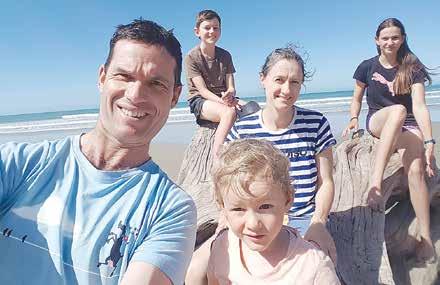 South Otago sheep and beef farmers Hamish and Amy Bielski and family.
South Otago sheep and beef farmers Hamish and Amy Bielski and family.
RURAL NEWS // SEPTEMBER 27, 2022 22 OPINION
www.yamaha-motor.co.nz FIND YOUR LOCAL DEALER AT: OFFER AVAILABLE FROM 4 JUL 2022 TO 31 OCT 2022 *A finance rate of 4.95% p.a. is available to approved applicants of Yamaha Motor Finance New Zealand Limited (‘YMF’) across the AG125, AG200, TTR230/A, YFM350FA, YFM450FB, YFM450FB/P, YFM700FA, YFM700FB/P, YXC700P, YXE850P, YXF850, YXM700, YXM700S SE, YXE1000PSEM, YXF1000PSEM models. Offer ends on 31/10/2022 and is available on a loan term of 24 and 36 months on YMF’s Commercial Hire Purchase contract standard terms and conditions. Credit criteria and lending, fees, charges, and conditions apply including an establishment fee of $325, $10 PPSR fee and a dealer administration fee. Finance provided by YMF NZBN 9429036270798. FSP 9622. Offer only available at participating Yamaha dealerships, while stocks last. ^ Warranty cover is subject to a range of requirements including following the service schedule & applicable vehicle load/towing limits. Service Intervals are dependent on usage and environmental factors. 4.95% P.A. FIXED RATE* 24-36 MONTH LOAN TERM FINANCE AVAILABLE YAMAHA SERVICE INTERVALS UP TO 150 HOUR^ SERVICE INTERVALS YAMAHA RELIABILITY ON SELECTED ATV + ROV Grizzly 350, Kodiak 450/EPS, Kodiak 700 EPS, Grizzly 700 EPS/SE, Viking 3/se Viking 6, Wolverine X2/XTR/Utility/Rspec, Wolverine X4, Wolverine RMAX 2/4 XTR 1000 Grizzly 350, Kodiak 450/EPS, Kodiak 700 EPS, Grizzly 700 EPS/SE, Viking 3/se Viking 6, Wolverine X2/XTR/Utility/Rspec, Wolverine X4, Wolverine RMAX 2/4 XTR 1000 KODIAK 450 $11,825 EXC GST WOLVERINE X2 UTILITY $22,521 EXC GST AG125 $4,086 EXC GST 3 YEAR GENUINE^ FACTORY WARRANTY 24 & 36 MONTH LOAN TERMS AVAILABLE $325 ESTABLISHMENT FEE APPLIES
NEW ZEALAND has been robbed of an opportunity to shape welfare standards in the global trade of live animals, with the upcoming passage of a law that will end exports from this country as of April next year.
Once again, we have before us another exam ple of a government that prefers a cancel culture, rather than a constructive culture.
This ban came about on the back of the sinking of the Gulf Livestock 1 in 2019, in which two New Zealanders died.

That was a tragedy, and I do acknowledge those families involved. But the livestock trade will continue whether or not New Zealand is part of it. Now, unfortunately, other countries with less rigorous animal welfare standards will make up for the gap in the market as New Zealand with draws.
I for one would prefer to see cattle leaving for China from New Zealand on ships of the highest specifications spend ing three weeks on the water, rather than on a refurbished container ship from Latin America, where they will spend up
to two months.
The economic impact of this decision cannot be overlooked – or underes timated. An Infometrics economic impact report says it will reduce New Zealand’s GDP by $472 million a year and will cost breeders between $49,000 and $116,000 per farm per year.
But as New Zealanders grapple with the cost of living crisis that this Gov ernment has created, it would seem it would still prefer to ban an industry worth almost half a bil lion dollars, rather than work with it to improve it.
The Government did not carry out its own economic analysis, nor would it consider any of the proposed amend ments the National Party put forward.
To be clear, I have always acknowledged that substandard prac tices have occurred in this industry – which I, like most New Zealand ers, absolutely condemn and would not tolerate further.
However, here we have missed an opportunity to set in law regulations that would have ensured the safe and humane treat ment of animals on ships.

Much has been made by advocates of the sector
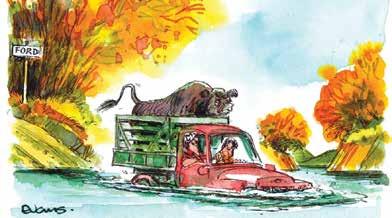
of the need to implement a ‘gold standard’ which has, unfortunately, con sistently been dismissed by Minister Damien O’Connor.
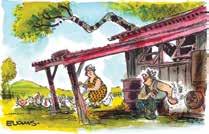
In my view, this is both short-sighted, and igno rant – because within a gold standard lies the solution to this problem.
Developed in 2020, the Gold Standard is a 12-point regulation framework to improve and modernise the export system.
If adopted, these improvements would go further than the addi tional requirements intro duced by MPI in October
2020, and exceed current international best prac tice.
The Gold Standard is a global-best prac tice system that is per formance-based, with all potential exporters licenced by MPI. At its heart is the assur ance of the good physical
and mental health in ani mals, including freedom from stress and good nutrition.
New Zealand’s cur rent exports require high animal welfare stan dards, but these are not enshrined in legislation. Surely, a far better solu tion for all involved –least of all the cattle we seek to better protect – is to legislate for strict stat utory criteria?
That would include things like built-forpurpose ships with stateof-the-art feed, water and air conditioning systems, as well as maximum stocking densities, vet and stock handler training, more robust reporting, exporter licensing and an importer quality assurance programme.
The National Party has consistently proposed amendments for the Gov ernment to consider
– everything from licens ing mechanisms and exporter/importer certifi cation mechanisms.
Most importantly, we suggested a clause where a future govern ment could instruct the Director-General of MPI to carry out a review on whether standards could be applied that would ensure the physical, health, and behavioural needs of the animals are met on board vessels.
Once regulations are made, exporters would be permitted to apply to the Director-General (of MPI), and he would be able to approve the export of live cattle on a case-by-case basis.
If National can form a government next year, we will commit to this review.
• Nicola Grigg is the National’s spokesperson on animal welfare and associate agriculture.
NICOLA GRIGG
I for one would prefer to see cattle leaving for China from New Zealand on ships of the highest specifications spending three weeks on the water, rather than on a refurbished container ship from Latin America, where they will spend up to two months.
Nicola Grigg (inset) believes that NZ has been robbed of an opportunity to shape welfare standards in the global trade of live animals with the passing of new legislation banning live cattle exports.
RURAL NEWS // SEPTEMBER 27, 2022 OPINION 23
Live cattle export ban a golden opportunity missed for NZ ag 2023 Edna Calendar T: 09-307 0399 then press 1 to be put through to reception E: julieb@ruralnews.co.nz ORDER NOW! ❱❱ $25 including post & packaging ❱❱ 12 of Edna’s best cartoons ❱❱ 330mm x 240mm, spiral bound EDNA!! EDNA CALENDAR 2023 “You do realise Edna, if we start to float, you’ll be breaking the law banning live animal shipments!” “Break my New Year resolution? - no way – it must be the Aussie bushfires you can smell!” RURAL NEWSFARMERS, FARMERS HORTNEWS SUNDAY MONDAY TUESDAY WEDNESDAY THURSDAY FRIDAY SATURDAY 1 2 3 4 5 6 87 9 10 11 12 13 1514 16 17 18 19 20 2221 23 24 25 26 27 2928 30 31 1 2 3 4 JANUARY FEBRUARY NEW OBSERVED WELLINGTON AUCKLANDANNIVERSARYANNIVERSARY
Paddock selection critical for winter crops
Farmers are being encouraged to carefully consider where and how they will establish next winter’s forage crops – taking into account soils, slope, water bodies, shelter, livestock classes and regulations.
BEEF + LAMB New Zealand’s (B+LNZ) environmental policy manager Heather McKay is urging farmers and contractors to think about this when sowing winter feed crops this spring.
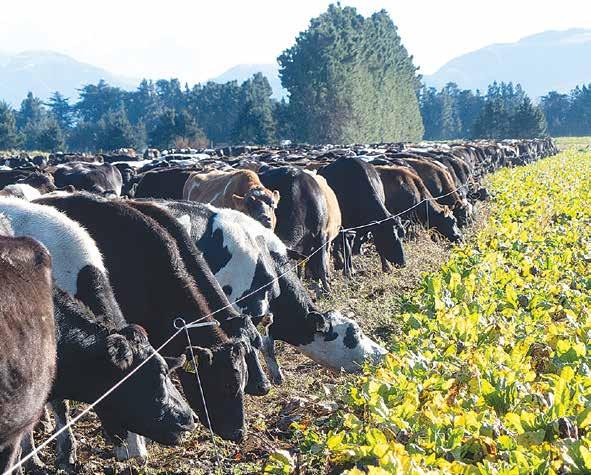
She says they need to consider both the Intensive Winter Grazing regulations (which come into force on 1 November) and the environmental impact of grow ing and grazing those crops. This means selecting the appropriate paddocks to minimise run-off while maintaining the highest standards of animal welfare.
“The way the crop is established, the type of crop, matching the stock class with the soil type and the appropriate graz ing management can all help ensure soil, water and nutrient resources are retained within the paddock and not lost to the environment,” McKay explains.
Identifying and isolating gullies, swales and drains, known as critical sources areas
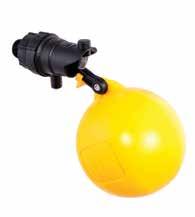
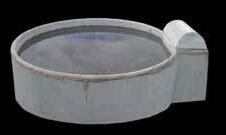


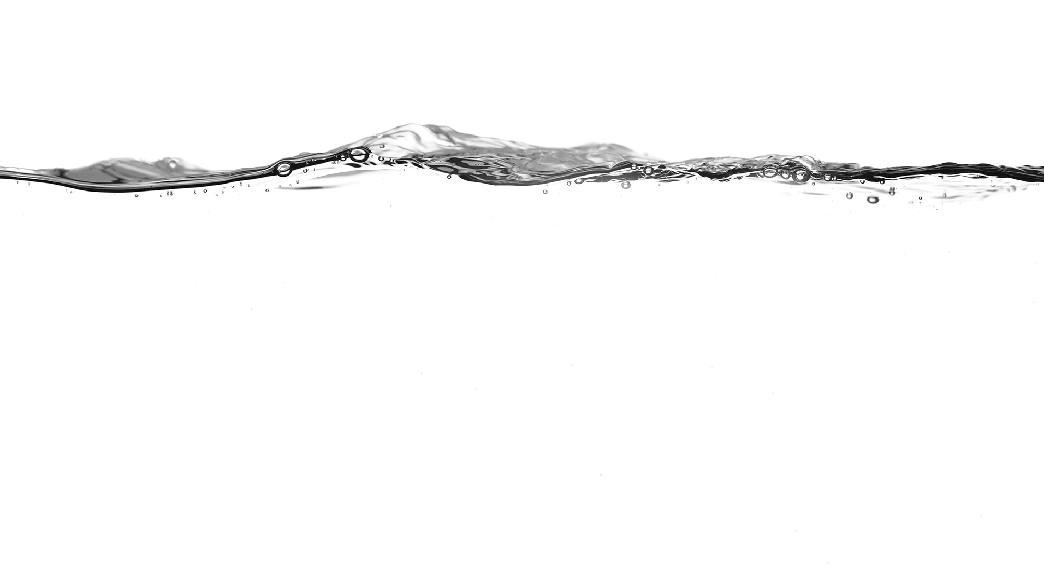
(CSAs) before establishing a crop (these must not be cultivated or sown in a forage crop) and ensuring there is a stand-off area for stock in wet weather will all help minimise the environmental impact of grazing forage crops over winter.
McKay encourages farmers to have an Intensive Winter Grazing Plan in place which identifies any risks associated with growing and grazing winter forage crops. This allows mitigation measures to be put in place early.
“Having a plan ensures the farm team is clear about what they need to do to ensure best-practice winter forage crop management is being followed from pad dock selection and crop establishment to post-grazing management.”
UNDERSTAND THE RISKS OF WINTER GRAZING
WINTER GRAZING can increase the risk of sediment, harmful bacteria and nutrients ending up in water.
Reducing this risk begins with paddock selection. Paddocks with water flowing through or over the soil present the most risk. For example: paddocks with sub soil drainage systems, paddocks on slopes or paddocks with stony free draining soils.
Once a suitable paddock has been identified, to reduce the risks think carefully about:
Establishment methods
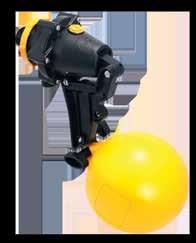
How they will be grazed

What animals will be grazing them Catchment-specific water quality issues
In catchments where nitrogen leaching is a problem, farmers should be aware that growing and inten sively grazing crops increases the risk of nitrogen leaching and should avoid intensively grazing on shallow, stony soils over winter. In catchments where phosphorus and sediment loss are the main issue, the focus should be on the proximity to water ways and reducing overland flow.
Soil type can impact productivity, nutrient loss and animal welfare.
Farmers with light or stony soils could consider using catch crops to capture nutrients. Ideally, only lighter classes of stock should graze on heavy soils during winter. Heavy soils are at greater risk of pugging, compaction and structural damage. On soils prone to pugging, consider leaving areas of the paddock in grass for animals to rest on.
Damage to soils from poor grazing management of winter crops will impact on the future productivity of that paddock.
At a glance – revised winter grazing regulations
● Pugging: farmers are required to take all practicable steps to minimise the effects of pugging on freshwater.
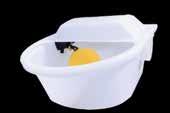
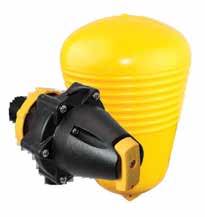
● Resowing dates: farmers have a duty to establish vegetation as ground cover as soon as practicable after grazing. This will help minimise nutrient and sediment losses from bare ground after winter grazing.
● Critical Source Areas: (gullies, swales or low-lying parts of a paddocks where run-off accumulates). These must be left ungrazed, have vegetation as ground cover and must not be cultivated in an annual forage crop. Critical source areas play a major role in reducing the loss of contaminants into waterways.
● Slope: land with a maximum slope of less than 10 degrees (the elevation differ ence across any 20-metre distance) may be used for intensive winter grazing. Farmers wanting to carry out intensive winter grazing on land with a slope of more than 10 degrees will either need a resource consent or a certified fresh water farm plan.
Farmers sowing winter feed crops this spring need to consider the new Intensive Winter Grazing regulations and the environmental impact of growing and grazing these crops.
RURAL NEWS // SEPTEMBER 27, 2022 24 MANAGEMENT
0800 JOBE VALVES jobevalves.com •Ideal for Cattle Troughs •High Flow •Side/Bottom Mount •Detach to Clean •Compact/Robust •Ideal for Small/Low Demand Troughs •Low Flow ve/Below Water Mount •Built in Check-Valve •Ideal for Compartment Troughs/Tanks •High Flow •Top Mount •Detach to Clean •Compact/Robust
Less pain – more gain!
A NEW rubber ring appli cator and pain relief delivery device, which provides up to 70% pain reduction in lambs after application, was recently put through its paces on farm.

The rather cheekily named Numnuts system has been introduced to the country by NZ vet erinary market supplier Agilis Vet. Earlier this month, a team from Agilis trialled the device on the South Canterbury farm of former Fed Farmers’ meat and wool chair Miles Anderson.
First devised in Scot land, then refined and commercialised in Aus tralia, the world-first product has a develop ment timeline stretching back to the mid-1990s.
The concept was origi nally prototyped and tri alled by scientists at the University of Edinburgh more than 20 years ago. While this proved suc cessful, the prototype was expensive and the project was shelved.
However, in 2009 sci entists at Edinburgh’s Moredun Research Insti tute teamed up with Glasgow-based innova tion and engineering spe cialists at 4c Design for a new start on the proj ect. Meat & Livestock Australia and Australian Wool Innovation came on board in 2012, followed by the Australian CSIRO in 2013.
The Numnuts system was developed for the Australian market, with MLA support in antici pation of the need for higher welfare standards on farm. It was scientifi cally evaluated, patented and field tested on 15,000
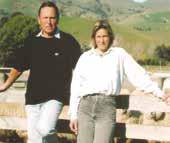
Australian lambs in 2018.
According to Agilis, the product has already begun transforming cas tration and tailing in Aus tralia, where 200,000 lambs received the treat ment in the first year after its pilot launch.
Said to be practical, safe and easy to use, the hand-held device applies elastrator rings over the lamb tail and also scro tum – while allowing users to inject pain relief at the same time. Num nuts’ ergonomic tool applies a standard rubber ring to cut off blood supply, while at the same time, adding targeted pain relief via a novel multi-stage injection mechanism.
Agilis says the reduc tion in pain has been validated in trials by CSIRO measuring the pain behaviours of lambs during these proce dures. NumOcaine is the approved local anaes thetic for the Num nuts system. It works by affecting the permeability of nerve cell membranes to sodium ions, thus blocking nerve impulse transmission. All nerves are affected but those concerned with pain and temperature are most sensitive and this hap pens rapidly when given by injection.
“NumOcaine is injected at the same time
as the ring application to the testes or tail provid ing targeted pain relief almost immediately,” explains Ann Wilkinson –technical vet and general manager of Agilis.
She says there is cur rently no other device on the market that allows farmers to provide tar geted pain relief to lambs during tail docking and castration.
Wilkinson says there has been some talk around regulations being introduced to mandate pain relief for docking lambs in NZ. However, she believes that there is currently no appetite for this.
“Instead, we are seeing the drive for pain relief coming from the compa nies supplying the retail sector, who are antici pating what a consumer might be looking for.”
Wilkinson cites Merino NZ is an example.
“Our role is to make the tool available to people who personally like the concept of pain relief and to make sure it works well for those who wish to supply particular markets that require it,” she adds.
“The concept of a safe delivery system in an ergonomic tool is our interest. Creating addi tional burdens and costs on unwilling farmers is not.”
FARMERS ARE being reminded about new lamb docking/tailing rules.
Tail length requirements were introduced as part of new animal welfare regulations last year. Beef + Lamb New Zealand (B+LNZ) is reminding farmers of the new regulations as docking gets underway throughout the country.
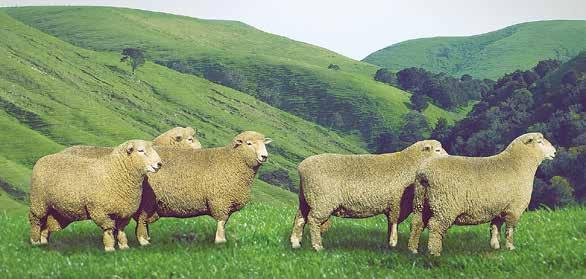
“The length of a docked tail must be no shorter than the distal end of the caudal fold, which is the end of the flaps of skin that attach the underside of the tail to the lamb’s body,” says B+LNZ’s Will Halliday.
“This is the absolute minimum length under the animal welfare regulations and docking tails shorter than this can lead to an infringement fee of $500.”
Under the new regulations, hot iron or rubber rings are the only methods that can be used to dock tails and the use of any other method can also lead to an infringement fee of $500. Halliday is also reminding farmers that only lambs under six months can be docked by farmers or staff. For lambs older than six months, the procedure must be carried out by a vet.
5-in-1
THE NUMNUTS system is comprised of five key elements that work together to deliver targeted, pain relief during tail docking and castration:
● Numnuts ring applicator
● Two-stage injector
● Fluid junction
● Numnuts-specific needles
● NumOcaine anaesthetic
Glenview RATE & SURVIVAL
• All
• Ram hoggets have been muscle since
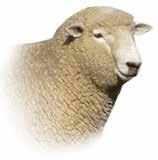
• Ewe have been over
• once
• Scored
• are ‘hands a
• We must
DAVID ANDERSON
The Numnuts device allows farmers to provide targeted pain relief to lambs during tail docking and castration.
RURAL NEWS // SEPTEMBER 27, 2022 ANIMAL HEALTH 25
GET THE LENGTH RIGHT
The concept was originally prototyped and trialled by scientists at the University of Edinburgh more than 20 years ago. While this proved successful, the prototype was expensive and the project was shelved.
Romneys Bred for high performance and ‘cast iron’ constitution We deliberately challenge our Romneys by farming them on unfertilised native hill country in order to provide the maximum selection pressure and expose ‘soft’ sheep. We aim to breed superior Romneys that produce the most from the least input. Glenview Romneys & South Suffolks GEOFF & BARB CROKER Longbush, RD 4, Masterton email: bob_barb@slingshot.co.nz www.glenviewromneys.co.nz Phone 06-372 7820 Over the last 20 years ewes (including 2ths) have scanned between 190% and 215% despite droughts. Over the same period weaning weights (adj. 100 days) have exceeded 36kg from a lambing % consistently above 150%. FERTILITY GROWTH
sheep DNA and SIL recorded.
eye
scanned
1996.
hoggets
mated (to Romney sires) for
20 years.
Breeding programme puts an emphasis on worm resilience - lambs drenched only
prior to autumn. FE tolerance introduced more recently.
for dags and feet shape. Sires DNA rated for footrot and cold tolerance.
We
on’ breeders with
focus on detail and quality.
take an uncompromising approach - sheep
constantly measure up.
New MF tractors arrive in NZ
MASSEY FERGUSON has launched its new MF 6S Series in New Zealand.
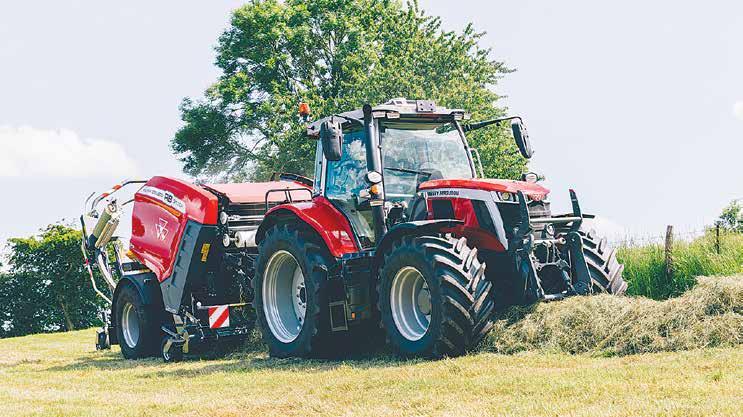
A range of modern, neo-retro tractors from 135 to 200hp, the new models take much of the design detail from the recently arrived 8S Series. Compact and powerful, the five model range is equipped with four-cylin der, 4.9 litre AgcoPower engines.
The 6S.135, 6S.145, 6S.155, 6S.165 and 6S.185 push out rated horse power of 135, 145, 155, 165 and 185hp respectively.
With Electronic Power Management (EPM), these outputs climb to 150, 160, 175, 185 and 200hp, while maxi mum torque outputs hit 650, 700, 750, 800 and 840Nm. An ‘all-in-one’ SCR system ensures the engines meet the latest Stage V emission stan dards, utilising a main tenance-free unit tucked neatly under the cab, with no impact on visibil ity or performance.
Transmission choice on all models includes seamless shifting from the Dyna-VT Super Eco, or the Dyna-6 SuperEco, semi-powershift

with AutoDrive. Designed and built ‘in-house’, both transmissions feature the Power Control lever on the left-hand side of the steering column. This provide clutchless F/R shuttling, with an adjust able response, shifts speeds up or down and selecting neutral.
Dyna-VT transmis sions are now equipped with a new Automatic Mode, allowing the oper ator to adjust forward speed with the Multipad lever or the foot pedal.
Meanwhile, the engine speed is automatically regulated according to the load and speed.
The hand throttle now also sets a lower engine speed limit – with rpm never dropping below this limit. The new Super Eco version of the DynaVT reduces fuel con sumption by achieving 40km/h at just 1,450rpm.
The Dyna-6 Super Eco 24 x 24 semi-powershift transmission achieves a top speed of 40km/h at a low 1,500rpm and fea
tures AutoDrive on all models to automati cally shift speeds rela tive to the engine load and speed. Those work ing in specialist crops can specify a Super Creeper option, which provides speeds down to 70m/h at 1,400 rpm.

All MF 6S tractors also provide the useful brake-to-neutral function, which also disengages drive when the brakes are applied.
Said to be light but immensely strong, the

range offers best-in-class power-to-weight ratio, along with high gross vehicle weights of up to 12.5 tonnes and gross combination weights of 44.5 tonnes. A turn ing radius of just 4.75m, combined with a 2.67m wheelbase, offers maxi mum manoeuvrability, said to be the tightest of any 200hp tractor.
The new MF 6S Series is available with Essen tial and Efficient levels of specification. Along with a wide range of options,
these allow owners to tailor their tractor and level of investment to match their specific requirements.


A new armrest, which is linked to the seat, con tains everything opera tors need to operate the engine, transmission, hydraulics, linkage and PTO as well as switches for the radio and phone. Loader operators will welcome the Visio Roof option, which greatly improves vision for han dling work, providing a
clear view of the load through the lift range.
All main tractor functions are run from a single new Multipad, ISOBUS-compatible controller.
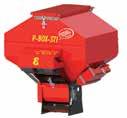

This covers functions such as linkage control, cruise settings, driving mode pre-sets and MF Guide activation – as well as a micro joystick to control two electric spool valves. Another multifunction joystick option offers control of the loader or front linkage, as well as enabling operators to change direction and control the tractor speed. Significant changes to the modern Datatronic 5 terminal increase functionality, utilising a brighter, 9” touchscreen with an anti-glare surface, new short-cut keys and tablet style operation.
At the business end, a 9,600kg rear linkage capacity and powerful 110 litre/min closedcentre, load-sensing hydraulics allow easy operation of a wide range of implements. Those requiring more flow can specify a 150 litre/min option Dyna-6 models, while Dyna-VT tractors come with a 190 litre/min option.
MARK DANIEL
RURAL NEWS // SEPTEMBER 27, 2022 26 MACHINERY & PRODUCTS
markd@ruralnews.co.nz The new MF 6S.180 tractor with a RB3130F baler in action. IT’S QUICK, IT’S CONVENIENT, IT’S EFFICIENT ROUND BALEAGE TIPPER • Thick layers of plastic on bale ends provide superior protection against ground moisture and weather while stored. • No flat sided bales (simplifies feeding out). • Less storage area required. • Suitable for medium HP tractors. • 3PL mounted (no front axle stress). • Bale tipped in one easy movement. • No need to reposition bale before tipping. • Simply trip and flip. Maitland - RD5 - Gore Phone/Fax 03-207 1837 or 027-628 5695 www.james-engineering.co.nz Transports and stands wrapped round bales on end for storage H NOW AVAILABLE AS A SINGLE OR DUAL UNIT H CONTACT US FOR YOUR LOCAL DEALER For more information call us on 06 370 0390 www.tulloch.nz Dealers located nationwide Seed distribution technology at its absolute finest. UNDERSOWER SEEDER With up to a 12m working width the Einböck PNEUMATICSTAR is the ideal machine for seeding large areas at very low cost. High quality, solid construction. The P-BOX STI pneumatic air seeder is highly accurate for broadcasting seeds like grass or brassicas. Easy adjustment from 1kg to 300 kg/ha. Plug and play using the Info plug on your tractor (for radar speed and linkage position). PNEUMATIC AIRSEEDER
Kuhn balers aim for consistent and constant high performance

KUHN HAS introduced the new VB 7100 series balers, aimed at large farmers and contractors looking for a high-perfor mance machine.
These variable cham ber round balers are said to create bales of up to 140 kg/m3 in straw with a capacity of up to 30 tonnes/hour – subject to crop conditions.
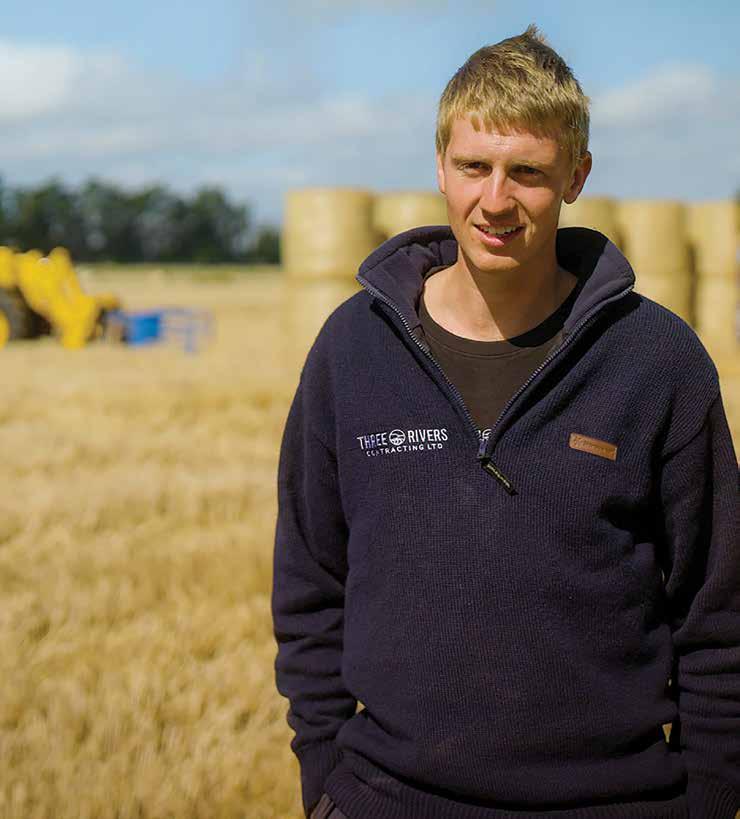
The VB 7100 series features the new KUHN patented system i-DENSE, utilising a twin tension arm system to provide high bale densi ties. Working in combi nation with a moisture sensor, this automatically adapts the baling pressure – according to the differ ent crops and crop con ditions – without input from the driver.
The i-DENSE system and the 4 belt/3 roller design in the bale cham ber is said to ensure a consistent bale forma tion in any crop condi tion. This is helped by the integral rotor at the pickup that promotes an even crop flow. The machine also features the fastest tailgate operation in the marketplace – taking only 4 seconds from bale’s ejection to fully closing the tailgate.
Extreme durability is achieved with the use of oversized components, wear resistant and over


sized chains, with an automated continuous chain greasing system. Rotor tines are manufac tured from of HARDOX wear plate, while 50 mm spherical roller bearings are fitted on the main driven rollers with special KUHN-patented seals on the idling rollers.
Operator convenience has also been made a focal point, with the baler taking control of the baling density and power consumption. Meanwhile, moisture indication and many other data points can be monitored at the ISOBUS display terminal.
The net wrapping system is easy loading from both sides of the machine from ground level, utilising new KUHN-patented sup port brackets. This allows net rolls to slide easily from the storage posi tion, without needing to lift the whole roll. Switch ing between the different sets of knives is quick and easy when using KUHN’s proven GROUP SELEC TION technology.
Two models, the 7160 and 7190, pro duce 1.60m and 1.85m round bales respectively. Both machines are fully ISOBUS compatible, allowing the intuitive user interface to be displayed on an ISOBUS tractor ter minal, or on CCI 800 or CCI 1200 terminals sup plied by KUHN. www.kuhn.co.nz
JEFF ROBINSON
...is happy to ‘talk up’ the benefits of his JCB SERIES III to his contracting business. We challenged him to see the advantages of owning a second one.
Here’s what he said...
 MARK DANIEL markd@ruralnews.co.nz
Kuhn’s new VB 7100 series balers are aimed at large farmers and contractors looking for a high-performance machine.
Jeff Robinson of Three Rivers Contracting in Southland relies on his JCB SERIES III AGRI to speed up operations, both in the yard and out in the field. In off a spanking new JCB SERIES AGRI with
MARK DANIEL markd@ruralnews.co.nz
Kuhn’s new VB 7100 series balers are aimed at large farmers and contractors looking for a high-performance machine.
Jeff Robinson of Three Rivers Contracting in Southland relies on his JCB SERIES III AGRI to speed up operations, both in the yard and out in the field. In off a spanking new JCB SERIES AGRI with
RURAL NEWS // SEPTEMBER 27, 2022 MACHINERY & PRODUCTS 27
Read us until the cows come home! www.ruralnews.co.nz
fact Jeff loves his JCB so much, we thought we’d drop
brand
III
SUPER, leave it
him for a day and return the next day to see if he would consider the benefits of having two JCB’s in his fleet. Already familiar with the efficiency, manoeuvrablity and speed of his JCB LOADALL, Jeff was in no doubt how much his operation would benefit from having a second one. SEE THE FULL STORY & MORE INFO AT JCBAGRICULTURE.CO.NZ WHAT COULD YOU DO IN A JCB SERIES III LOADALL?
LAN 2394 “ IT’S GREAT FOR DOING JOBS WE CAN’T GET A TRACTOR TO DO.”
Autonomous spreader unveiled



CASE IH has partnered with Raven Industries to launch the Trident 5550 applicator, understood to be the agricultural indus try’s first autonomous spreader.

Aimed at a market looking to solve the chal lenges of labour shortages and the need to improve efficiency, the Trident 5550 applicator combines proven Raven Autonomy driverless technology with an agronomicallydesigned spreading platform for a flexible
autonomous solution. Raven uses its proprietary software to control guid ance and steering, speed control and path plan ning.
In operation, likely using a mobile device, operators can plan and complete the spread ing function based on mapped field bound aries. Using a series of advanced cameras and a radar system, the Raven Autonomy system con stantly senses a 360degree environment around the machine look ing for obstacles and motion initiation while
operating. A perception controller processes the continuous stream of images, which interprets
and detects obstacles, with a link back to the remote operator to view the cameras at any time.
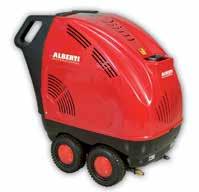

If an obstacle is detected, the machine will safely come to a stop and an alert will be sent to the operator’s mobile device. At this point, the operator can evaluate the situation and determine the next course of action.
Additionally, a range of machine tasks and functions can be viewed remotely. These include fuel and DEF levels, vehi


cle speed, hopper levels, Universal Terminal infor mation and diagnostic fault codes.




This latest innova tion follows on from the Case IH autonomous concept vehicle launched in 2016. It comes after research found autono mous spreading was an operation that customers would likely adopt.
The Case IH Trident
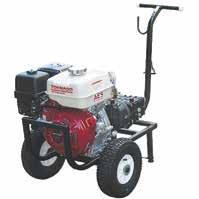
5550 allows for one or more driverless machines in the paddock with out an operator present. However, it also provides the flexibility of full con trol inside should it be required.
By operating at a constant speed and with precision, the autonomous applicator should provide spreading consistency – with human error removed –and allow for repeatable performance with centimetre accuracy.

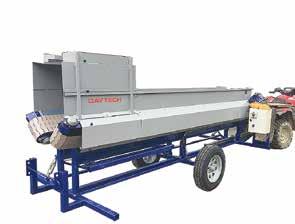
“This is a significant milestone in our accel erated product develop ment efforts between Case IH and Raven,” says Scott Harris, Case IH global brand president. “It highlights our intense collaboration and robust product innovation fol lowing CNH Industrial’s acquisition of Raven in late 2021.”
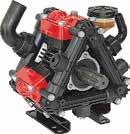

 MARK
Case IH’s Trident 5550 applicator is understood to be the agricultural industry’s first autonomous spreader.
MARK
Case IH’s Trident 5550 applicator is understood to be the agricultural industry’s first autonomous spreader.
RURAL NEWS // SEPTEMBER 27, 2022 28 MACHINERY & PRODUCTS
DANIEL markd@ruralnews.co.nz
Ph Stuart 0274-387 528 or 06-370 1329 Ph Phil 021-378 858 124 Lincoln Road, Masterton E: daytech@wise.net.nz W: www.daytech.co.nz LEADERS ON FARM MACHINERY DESIGN WOOD SPLITTERS QUALITY YOU CAN RELY ON DT 20 FLAT DECK CONVEYORS • Feeds any size bale • Self loading • Feeds bailage, haw, straw • Ask about different trailer options • Built strong with double skinned main beam. • 4” x 2.5” ram. Good cycle time. • 2-stage hydraulic pump coupled to a genuine Honda motor. • Heavy duty braked • Deck heights 600mm & 725mm • 18mm single piece tread deck • 2x3 metre deck plus fold down head board • 22 tie down points BALE FEEDERS See us at the Gisborne, Hawkes Bay & Carterton A&P Shows Contact AES direct or your local AES dealer FREEPHONE 0508 78 78 78 46 Sir William Ave, East Tamaki, Auckland www.aesblasters.co.nz TORNADO RANGE Robust UDOR Italian ceramic plunger pump with brass head. 10 models. Choice of direct drive or low rpm pump with gear box. Genuine Honda with 3 yr warranty. ELECTROBLAST RANGE Two 230 volt and four 400 volt models with UDOR ceramic plunger pump & low rpm 4 pole (1440 rpm) motor for extended service life. ALBERTI HOT CLEANERS UDOR ceramic plunger pump. Heavy-duty 4 pole electric motor. 230 & 400-volt models. Diesel hot water heater. HURRICANE PTO WATERBLASTER/ SPRAYER 250 or 600 litre tank, 540 rpm gearbox. New UDOR 3000 psi 35L/ min pump. MULTI PURPOSE UNIT • Blast • Spray • Drain clean! AES SPRAYPACK 250 & 600 250 and 600 litre tanks, galvanised frame. HD quick release, PTO shaft, 53L/min spray pump, 25m hose & hand gun, optional 6 metre boom. UDOR High quality Italian diaphragm pumps. From 17L/min to 240L/min. 290 psi to 580 psi SPRAY BOOMS 4.5 6 & 8m metre spray booms, horizontal fold, stainless steel lines and non-drip low drift nozzles. HOSE REELS 100 or 150m SPRAY HOSE 25, 50, or 100m coils SAVE $$$ VALUE!UNBEATABLE TODAY.CALLUS SPRINGCLEANUPSALE SAVE $$$ SAVE UP TO $400 PHONE FOR HOT PRICES BUY MADENZ &KEEP WORKING!KIWIS
New Juwel in plough range
lic working width adjust ment.
LEMKEN HAS intro duced the lightweight Juwel 6 to its plough range, which is designed to complement the Juwel 7, 8 and 10 mounted, reversible ploughs.
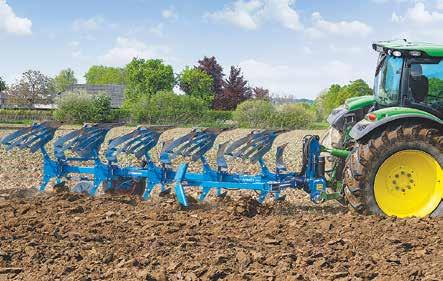
From next year, the new low-draught model will replace the EurO pal and VariOpal 5 and 6 ranges. These ploughs have been a byword for good work results and durability for the past 25 years.
Suitable for tractors from 70 to 130hp, the Juwel 6 features a 110mm box section frame, with an underframe clearance of 80cm and a choice of 3, 4 or 5 furrows. The M version offers four differ ent working widths per body, adjusted mechan ically. Meanwhile, the Juwel 6 M V features an infinitely variable hydrau

Hydraulic frame swiv eling is available as an optional extra. When combined with the iQblue Connect electronics kit, the implement can be transformed into a smart plough with ISOBUS con trol and connected to your farm management system.
Basic equipment includes the tried-and-tested Dural bodies, with the option of DuraMaxx bodies made from specially-hardened steel available to increase component life and dura bility. As with all Lemken mounted reversible ploughs, the Optiquick adjustment system for side draught-free work is a standard fitment.
All mounted ploughs are equipped with new pendulum format wheel assembly, the height of which can be adjusted without tools via a series
ANTARCTICA BOUND
NORMALLY SEEN in the grain growing areas of Canterbury, three Case IH Steiger Quadtracs will soon be heading off and swapping the heat and dust for the ice and snow of Antarctica.
The Australian Antarctic Division (AAD) will take delivery of three 500hp prime movers that will even tually be put to work in the challenging conditions of the world’s coldest continent. The main functions for the tractors will be to support aviation operations at the Wilkins Blue Ice Runway, 70km inland from Casey Station as well as at the Casey Ski Landing Area, 15km from the station.
The tractors will undertake tasks including pull ing a 90-tonne proof roller that is used to construct the runway, fuel and cargo transport duties, along side general sled towing and heavy vehicle recovery.
Manufactured at Case IH’s plant in Fargo, North Dakota, two of the three modified Antarctic-bound Case IH Steiger Quadtracs, have been sent to USbased farm equipment supplier Grouser for nec essary modifications. This is before they arrive in Australia for final testing in Hobart, where they will be transported by ship to Antarctica.
Needing to be heavily modified for the Antarctica conditions to cope with the cold, the machines will have arctic hoses installed in key areas, as well as heaters fitted for warming of the coolant and engine oil circuits before start-up. Additionally, the tractors’ fuel tanks will be tripled in capacity to increase their versatility.
The tractors are due in Australia later this year, where they’ll be taken to Hobart for some final test ing before being craned onto the ship for the final leg of their journey to Antarctica.
of holes.
For material protec tion and greater working comfort, hydraulic sus pension is also fitted to the depth wheel. A simple
conversion kit is available if you want to upgrade to a Uni wheel for road transport.
MARK DANIEL markd@ruralnews.co.nz
Lemken says the lightweight Juwel 6 plough is suited for tractors from 70 to 130hp.
RURAL NEWS // SEPTEMBER 27, 2022 MACHINERY & PRODUCTS 29
@rural_news facebook.com/ruralnews NEW MF 7S | 145 – 210 HP NOW IS THE TIME TO SECURE YOUR NEW MF 7S. Speak to your local Massey Ferguson dealer for more information. WWW.MASSEYFERGUSON.CO.NZ FREECALL 0800 825 872 NEW MF 7S POWERFUL DESIGN TO INCREASE PRODUCTIVITY FULL OF TORQUE & POWERFULLY CAPABLE AGCO Power™ 6.6 litre, 6-cylinder engine with no Adblue, delivering power, efficiency and fuel economy. DYNA-6 & DYNA-VT TRANSMISSIONS Easy to use, efficient and comfortable. 2.88M WHEELBASE FOR THE PERFECT POWER Optimum stability with high levels of ground traction. SMART & SUSTAINABLE FARMING TECHNOLOGIES Significant fuel savings, no overlap and less fatigue. is a global brand of AGCO corporation 212234_MF_7S_Launch_RuralNewsNZ_FP_187x280mm AVAILABLE TO ORDER NOW
Machinery sales approach record highs, but how long will it last?
MARK DANIEL markd@ruralnews.co.nz

THE TRACTOR and Machinery Association (TAMA) conference, recently held in Christ church, took a closer look at how the agricultural
machinery industry was tracking in these troubled times.
With sales of new tractors always acting as a barometer for the rest of the industry, statistics specialists Agriview went over the figures. Its anal


ysis showed that during the last decade or so, a low of 3,321 tractors were sold in 2012 and a high of 4,640 units sold in 2019.
Tractor sales dropped to 4,192 in 2021 – no doubt constrained by Covid-induced poor com
ponent supply, low pro duction figures and freight problems.

Looking at the cur rent year to the end of July, the rolling average sat at 4,529 units. This is quite close to the peak of 2019. Meanwhile, the year-to-date figures hit 2,443 units, compared to 2076 for the same period in 2021.
Looking at these num bers in more detail, the North Island contrib uted 1,578 units (+12.6%), while the South Island sat at 845 units (+25.4%). The former showed a market increase of 25.3% in Waikato and a climb of 41.5% in Taranaki. However, the Manawatu and Wairarapa regions recorded a negative trend down by 5.8% and 6.2%
respectively.
Further south, stand outs included South Canterbury (+36%), Southland (+48%) and Otago climbed by a whopping 52.4%.
The breakdown of those tractors sales saw that the key 100 to 180hp sector was up by 29% (1,170 units), 180hp+ was up 20% (181 units). Meanwhile, the under 40hp and 40 to 100hp sectors, showed climbs of 4% (499 units) and 6% (573 units) respectively.
In the machin ery arena, 2021 showed good gains on the pre vious year with balers and hay tools hitting 1,825 machines, harvest ers jumping from 10 to 25 units, while the till age and seeding category
had dropped by around 50 units to settle at 392 machines.

Sprayers and slurry tankers was a mixed bag, the former growing by around 120 units to record 1,588 units, while the latter dropped by a similar number to finish at 575 machines.
In total, 4,788 machines were sold in 2021, compared to 4,119 units in 2020 – a signifi cant rise of around 16%.
While 2021 industry figures were undoubt edly stymied by supply and shipping constraints, industry sources suggest that 2022 will finish at higher levels in both trac tors and machinery.
However, distributors are already suggesting that some categories of





implements are in short supply or will arrive too late for the advancing season – likely leading to order cancellations. Without doubt, the next 12 to 18 months will see continued global dis ruption to the supply chain, not least due to restricted compo nent supply issues, most recently attributed to the Ukrainian conflict. In addition, shipping costs are unlikely to fall to any great extent. Shipping schedules are expected to remain erratic, while labour shortages, inflation and higher finance costs will all have a major influence on the final numbers in the 2022 sales year.
@rural_news












 Sales of new tractors are seen as a barometer for the rest of the industry.
Sales of new tractors are seen as a barometer for the rest of the industry.
RURAL NEWS // SEPTEMBER 27, 2022 30 MACHINERY & PRODUCTS / RURAL TRADER ONE STOP WATER SHOP CULVERT PIPES Phone 06 323 4181 or 0800 625 826 for your nearest stockist New Zealand’s CHEAPEST Culvert Pipes! FREE joiners supplied on request. •Lightweight,easytoinstall •Madefrompolyethylene Check out our NEW website www.mckeeplastics.co.nz 300mm x 6 metre $410 400mm x 6 metre $515 500mm x 6 metre $735 600mm x 6 metre $989 800mm x 6 metre $1496 1000mm x 6 metre $2325 1200mm x 6 metre $3699 Joiners supplied FREE with culvert pipes ALL PRICES INCLUDE G.S.T. BURGESS RUBBER UTE TRAY MAT WWW.BURGESSMATTING.CO.NZ CALL US ON 0800 80 85 70 For a Quadbar, call me, Stuart Davidson, owner of Quadbar NZ, on 021-182 8115. Email sales@quadbar.co.nz or for more info go to www.quadbar.co.nz QUADBAR Proven beyond doubt! “I have no doubt that if I did not have a Quadbar fitted, my accident would have been fatal!” – Rozel Farms “The Quadbar saved our employee from significant injuries.” – Colin van der Geest QUADBAR 5 YEAR SURVEY 600 500 400 300 200 100 0 NUMBER OF QUADBARS 479 ROLLOVERS 61 NUMBER OF DEATHS 0 $595 +GST delivered Recommended by Worksafe. ACC subsidy available
facebook.com/ruralnews
•
ESCORTED TOURS 2022/23













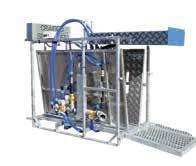
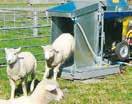



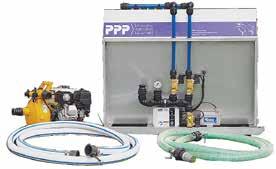















• FAR NORTH & BAY OF ISLANDS
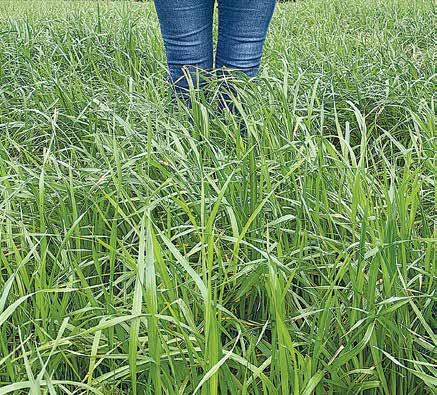
• COAST
•


• PLYMOUTH
•

RURAL NEWS // SEPTEMBER 27, 2022 RURAL TRADER 31
"Hassle free travel for mature travellers’’
(4 spots available) 7 days, depart 17 September. A leisurely coach tour of the Far North including the new Hundertwasser Art Centre and day trip to Cape Reinga.
EAST
& NAPIER (6 spots available) 8 days, depart 21 September A unique and exciting tour around the East Cape and return via the Northern Explorer train
CHATHAM ISLANDS DISCOVERY 8 days, depart 20 October A special place for a safe and relaxing close to home all inclusive holiday.
BEST OF THE SOUTH ISLAND 15 days, depart 22 November A spectacular trip around the many highlights of the South Island taking in the wonders of Tekapo, Twizel, Stewart Island day excursion, the Milford Sound and Queenstown. Overnight cruise on the Milford Sound
NEW
'CHRISTMAS LIGHTS' 5 days, depart 23 December A Christmas get away featuring the magnificent light display at Pukekura Park along with some great sightseeing during the trip.
WAIKIKI BEACH & HAWAII CRUISE 11 days, depart 25 May 2023 A 'Pride of America' cruise for 7 nights with a Waikiki highlights 3 day stop over including Pearl Harbor and Oahu round Island tour. • TAHITI & SOCIETY ISLANDS CRUISE 10 days, depart 21 July 2023 Set sail on board Le Paul Gauguin for an unforgettable journey to discover idyllic sands and atolls. Tour includes flights to/from Papeete. For full details Phone 0800 11 60 60 www.travelwiseholidays.co.nz Invest in your safety The world’s first flexible roll bar 0800 782 376 traxequipment.co.nz Rebate Available $1440 + GST & Freight $7680 +GST INCLUDES: • Jetter unit • Pump & Hose kit • Delivery to nearest main centre CONTROL FLYSTRIKE & LICE SUPPLYING FARMERS SINCE 1962 Free Range & Barn Eggs SUPPLIERS OF: • Nest boxes - manual or automated • Feed & Drinking • Plastic egg trays QUALITY PRODUCTS MADE IN EUROPE OR BY PPP ❖ A trusted name in Poultry Industry for over 50 years ❖ FLY OR LICE PROBLEMS? The magic eye sheepjetter since 1989 Quality construction and options • Get the contractors choice 07 573 8512 | dipping@electrodip.co.nz – www.electrodip.com Featuring... • Incredible chemical economy • Amazing ease 1500+ per hour • Unique self adjusting sides • Environmentally and user friendly • Automatically activated • Proven effective on lice as well as fly • Compatible with all dip chemicals • Accurate, effective application CRAIGCO SENSOR JET • Robust construction • Auto shut gate • Total 20 jets • Lambs only 5 jets • Side jets for lice • Adjustable V panels • Davey Twin Impellor Pump • 6.5 or 9.0hp motors PH 06-835 6863 • MOB 021-061 1800 JETTER VIDEO: www.craigcojetters.com SHEEP JETTERS SINCE 1992 GUARANTEED PERFORMANCE QUICK TO SETUP – EASY TO USE – JOB DONE DOLOMITE NZ’s finest BioGro certified Mg fertiliser For a delivered price call... 0800 436 566 For details contact: JULIE BEECH Ph 09-307 0399 • julieb@ruralnews.co.nz PLACE YOUR ADVERT HERE T/F 03 214 4262 E info@morrifield.com www.morrifield.com Quality Greenhouses • Easy assembly • Strong and durable • NZ made since 1980 • Grow all year round 40 YEARS IN BUSINESS morrifield PROUD TO BE NEW ZEALAND MADEWin!! MORRIFIELD GREENHOUSES Thank you to our Valued Customers for your continued support over the years www.morrifield.comGreenhouses Range of models sized 2 metres - 10 metres LASER FF95 DIESEL HEATER 0800 379 247 www avonheating co nz ü Huge 9.5kW output. ü Made in Japan since 1991. ü Energy Efficient - 92% certified ü Safe, convenient and easy to useno mess, no fuss. ü DIY Install or we can arrange. ü No wood to cut, cart or store. ü NO indoor diesel odours Docking Chute 0800 DOCKER (362 537) www.vetmarker.co.nz VETMARKER® SALE ends soon JACKET BIB OVERALLS LEGGINGS 100% Waterproof Flexible Fleece Collar Hood Visor Acid Resistant Durable SeamsStitched On Soles Plain Toe* or Steel Toe175% more crack resistant than normal leather Buffalo Leather earthwalk.co.nz free shipping0800 16 00 24 sizes: BOOTS 5 - 13 (NZ) RAINWEAR XS - 4XL9am-5pm PHONE NEW! BUFFALO BOOTS RAINWEAR BUY $160* $150*valued at $320 $280 valued at $230 New Zealand owned & operated NEW - WIDER TOE BOX NEW - WIDER STEEL CAP ** NEW - KEVLAR PENETRATION RESISTANT SOLE ** NEW - 250 DEGREE HEAT RESISTANT OUTSOLE NEW - BALL BEARING SPEED LACING NEW - FLEXIBLE RAND NEW - STRONGER OUTSOLE STITCHING NEW - STRONGER MIDSOLE NEW - STRONGER FORESTRY GRADE SHANK (**safety models) New boots arrive early November $109 $99$88 Outstanding in the field SPRING SOWING DELIVERED NATIONWIDE WITHIN 4-5 DAYS FROM ORDERING Ryegrass clover & brassica mixes Barley - Oats - Rye clover Phone 03 324 3951 or Nick 022 0833 579 www.cridgeseeds.co.nz
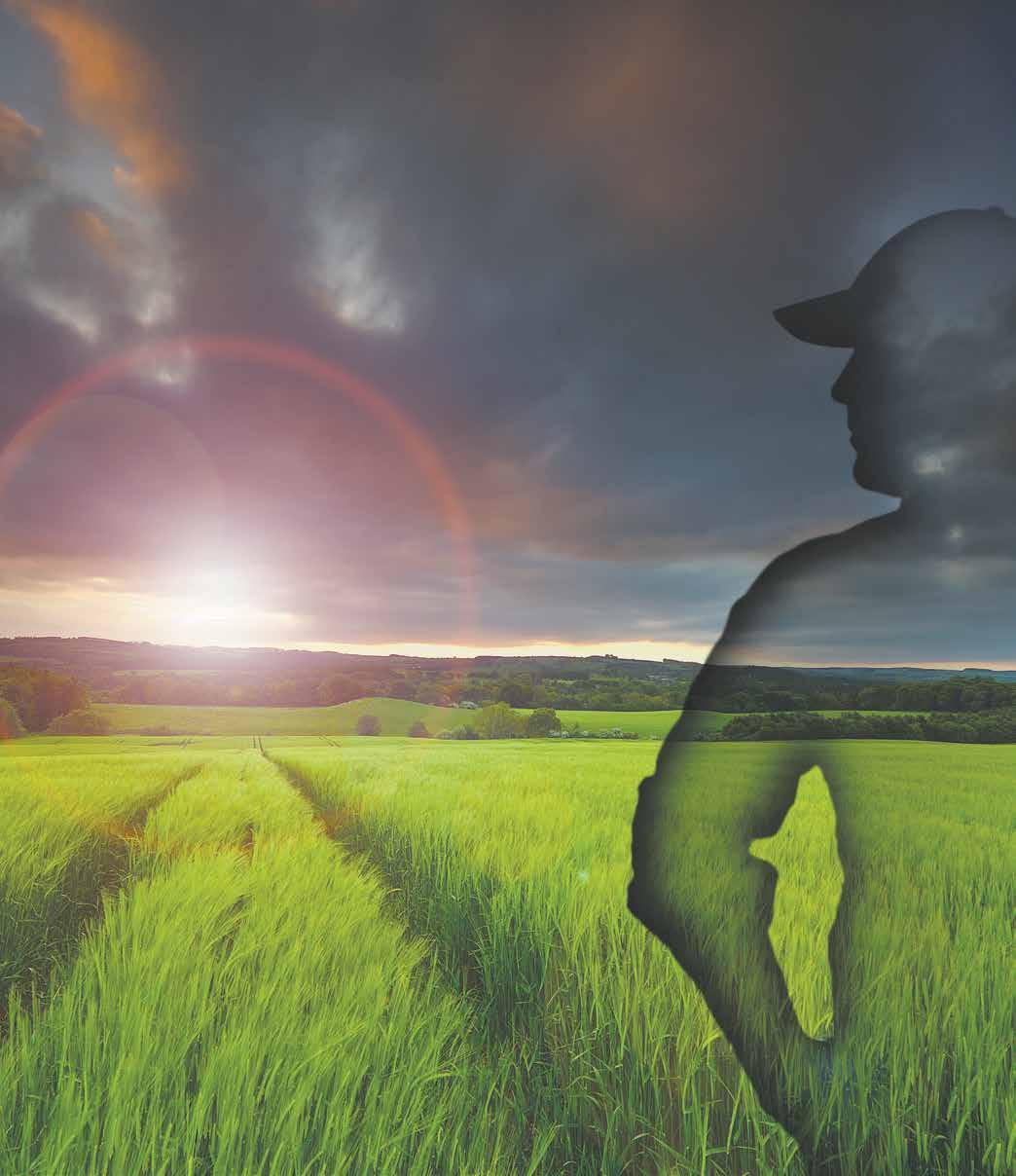










The first choice to combat Ramularia Visit crop-solutions.basf.co.nz or call your local area sales manager on 0800 932 273. ©Copyright BASF 2022. ®Registered trademark of BASF. 212505 09.2022 ALWAYS READ AND FOLLOW LABEL DIRECTIONS. Revystar Fungicide ACVM registration number: P009654. • A co-formulation of an SDHI Group 7 and latest generation triazole Group 3 fungicide. • Active on Scald and Brown rust in barley. • Superior and more consistent yields every season.

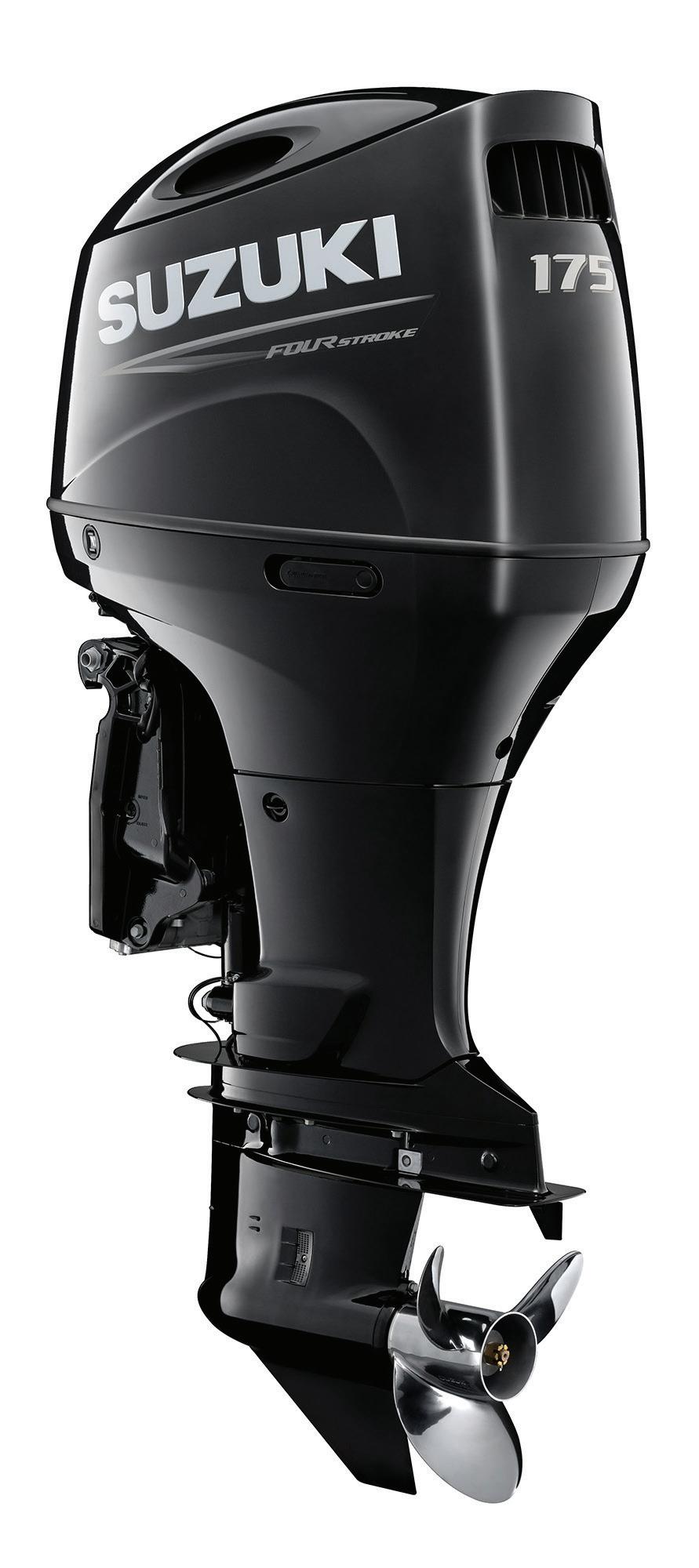
MORE REASONS TO REPOWER WITH SUZUKI Fully Fitted disclaimer: Offer is available on new Suzuki DF175AP between 01/10/22 to 31/12/22. Price includes side mount control, analogue gauge, propeller, and boat fitting. Price excludes removal of previous outboard motor and controls, repairs to electrical systems, fuel system/dash repairs, or steering systems, and transom repairs. Finance disclaimer: An interest rate of 5.99% p.a. is available to approved applicants of UDC Finance. Offer is available between 01/10/22 to 31/12/22 on a loan term of 36 months, from no deposit on regular monthly payments. Normal UDC lending and credit criteria apply and includes a $305 documentation fee and $10.35 PPSR. Excludes demo units and all other promotions. Available through participating Suzuki dealers, while stocks last. PRECISION CONTROL SPC Suzuki precision control is easy to operate with drive by wire throttle and shift control. Changing prop rotation on the 150/175/200 is electronic and means that a dual engine fit out doesn’t require a special motor. ENGINEERED PERFORMANCE Suzuki DF175 is equipped with variable valve timing which provides increased acceleration along with a smooth powerful torque curve. ANTI-CORROSION Suzuki’s anti corrosion finish is applied to the aluminium surface using high strength bonding to protect the exterior parts. LOW MAINTENANCE Fitted with a timing chain rather than cam belt means low maintenance and quiet operation. OFFSET DRIVE SHAFT By moving the powerhead closer to the transom Suzuki’s offset driveshaft means less vibration, better fuel economy and a more compact design. SPECIFICATIONS DURABILITY & RELIABILITY SDSM ANTI CORROSION PERFORMANCE 2.50 EASE & COMFORTECONOMY OPTIONAL*2 EASY START SYSTEM LEAN BURN Suzuki lean burn provides significant improvement in fuel economy in all speed ranges, especially at cruising speeds. $30,499 36 months at 5.99% based on regular monthly payments MORE FEATURES, BETTER BOATING DF175AP FROM NO DEPOSIT OPTIONAL OPTIONAL*1










DF6AS $1,999 ULTRA PORTABLE LIGHTEST IN ITS CLASS AT 24KG STORE ON 3 SIDES QUIET 6HP 4-STROKE THE UNDISPUTED LIGHTWEIGHT CHAMPION T&Cs apply. Promotion available from 1/10/22 to 31/12/22 on new Suzuki DF6AS/L, through participating Suzuki dealers while stocks last. Excludes demo units and all other promotions. Free Summer Safety Kit is available to the first 100 purchasers and valued at $160. Cannot be exchanged for cash. CALL YOUR LOCAL DEALER TO FIND OUT MORE OR GO TO MARINE.SUZUKI.CO.NZ PLUS FREE SUMMER SAFETY KIT WORTH $160 SUZUKI HUTCHWILCO LIFEJACKET • SUZUKI CAP • SUNBLOCK ALL IN A HANDY SUZUKI CARRY BAG.
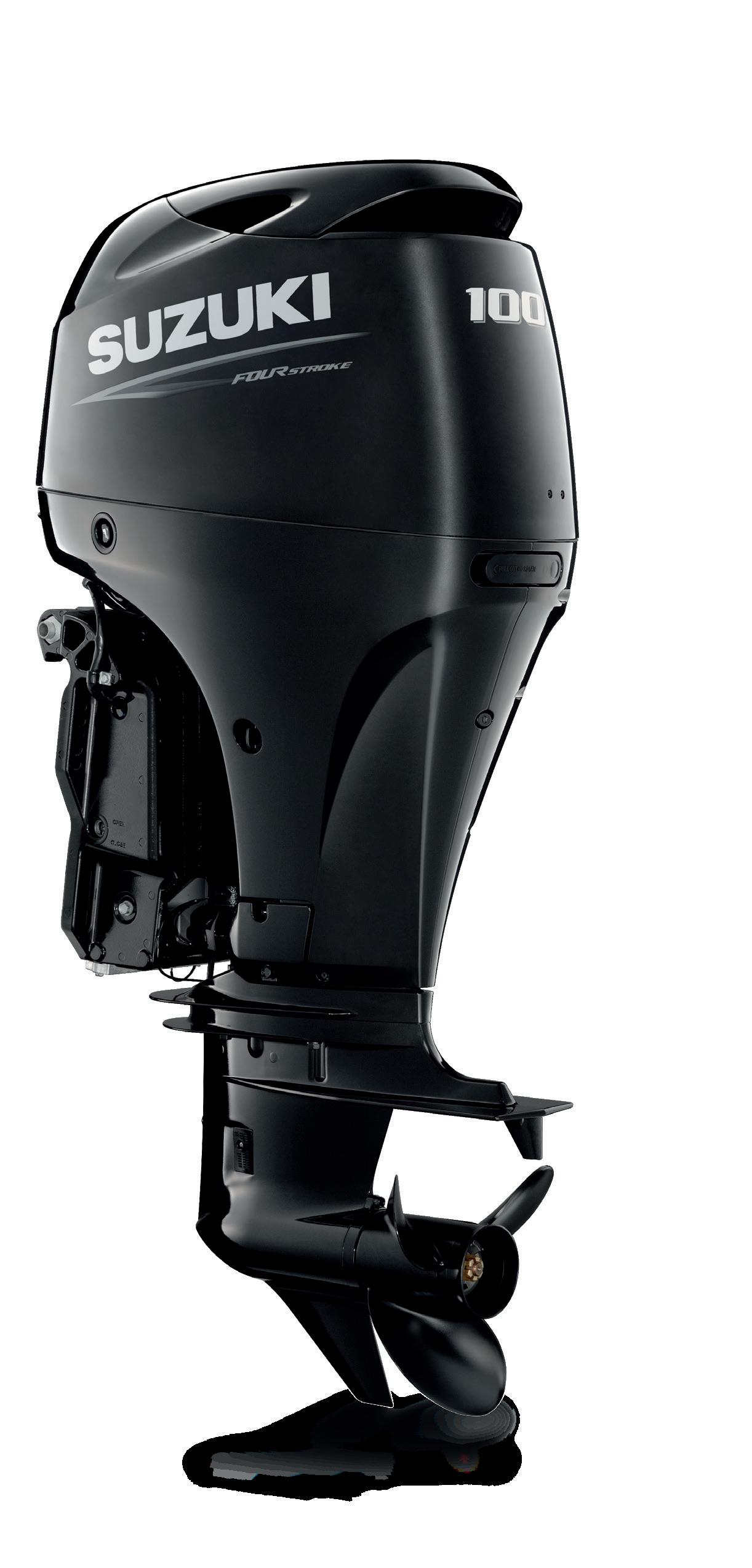
SUMMER OFFICIALLY STARTS IN DECEMBER. FOR $17,500 YOURS CAN START NOW. T&Cs Fully Fitted disclaimer: Offer is available on new Suzuki DF100BTL/X between 01/10/22 to 31/12/22. Price includes side mount control, analogue gauge, propeller, and boat fitting. Price excludes removal of previous outboard motor and controls, repairs to electrical systems, fuel system/dash repairs, or steering systems, and transom repairs. Finance disclaimer: An interest rate of 5.99% p.a. is available to approved applicants of UDC Finance. Offer is available between 01/10/22 to 31/12/22 on a loan term of 36 months, from no deposit based on regular monthly payments. Normal UDC lending and credit criteria apply and includes a $305 documentation fee and $10.35 PPSR. Excludes demo units and all other promotions. Available through participating Suzuki dealers, while stocks last. Upgrade now to the powerful, quiet and reliable 4-stroke Suzuki DF100B for just $17,500 Fully Fitted, from no deposit and 5.99% p.a. interest and the summer feels will start immediately. Call into your nearest participating Suzuki dealer today or visit marine.suzuki.co.nz






T&Cs: Promotion available between 26/9/22 to 31/12/22 on new Suzuki JR80, DR-Z125, DR-Z125L, LT-Z50 and LT-Z90. Free Tool Set is covered by the manufacturer’s warranty, and valued at $79.98. Available through participating authorised Suzuki dealers. An interest rate of 5.99% p.a. is available to approved applicants of UDC Finance. Offer is available between 26/09/22 to 31/12/22 on a loan term of 24 months, from no deposit on regular monthly payments. Normal UDC lending and credit criteria apply and includes a $305 documentation fee and $10.35 PPSR. TRACTA65225_RNSI Thiswonpresent ’t fit underthebed. But it will fit your Christmas budget! 61 PIECE TOOL SET PLUS FROM NO DEPOSIT 24 MONTHS TO PAY!FREE suzuki.co.nz STANDOUT SUZUKI DEALS FOR A SUMMER OF FUN
